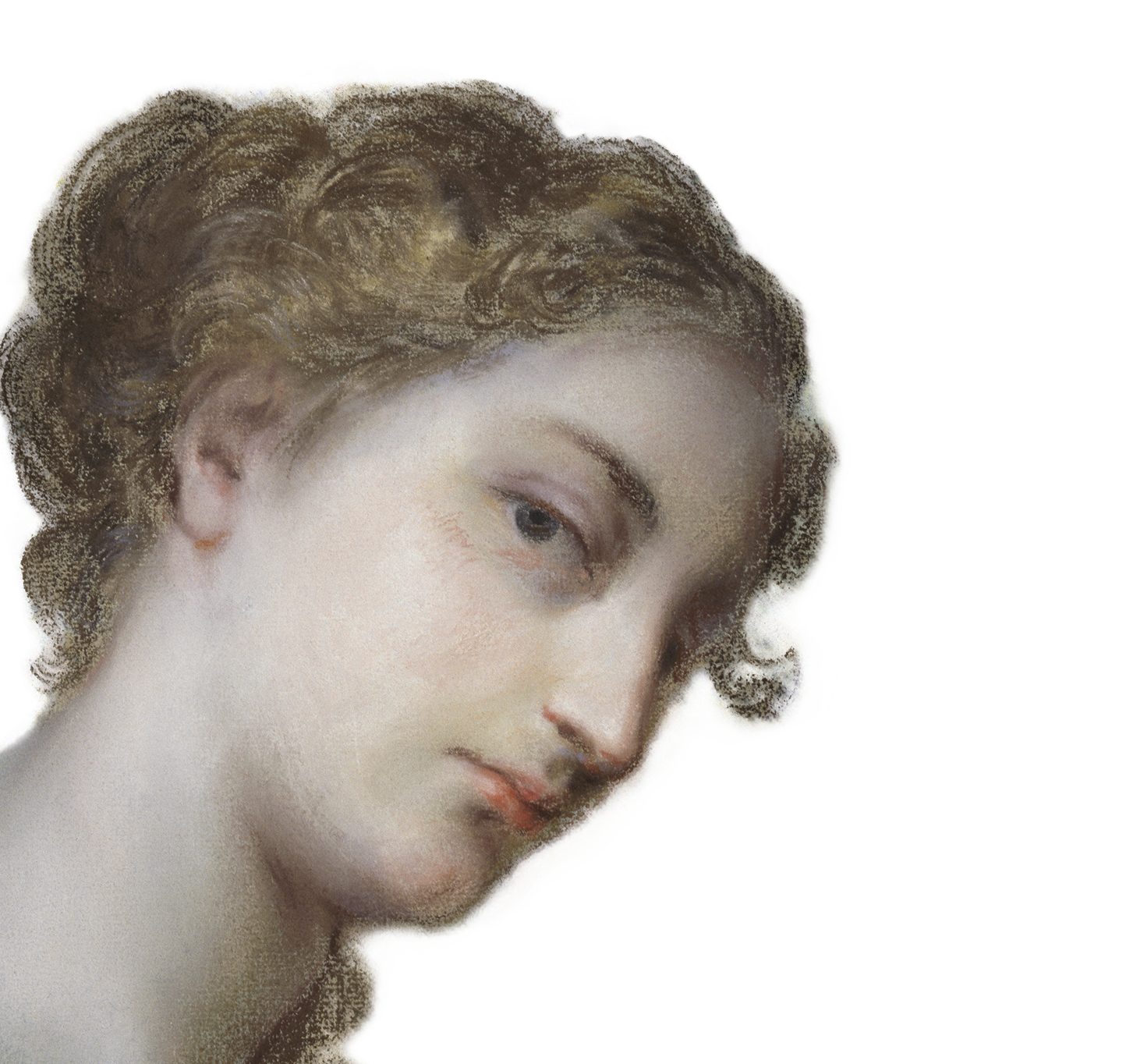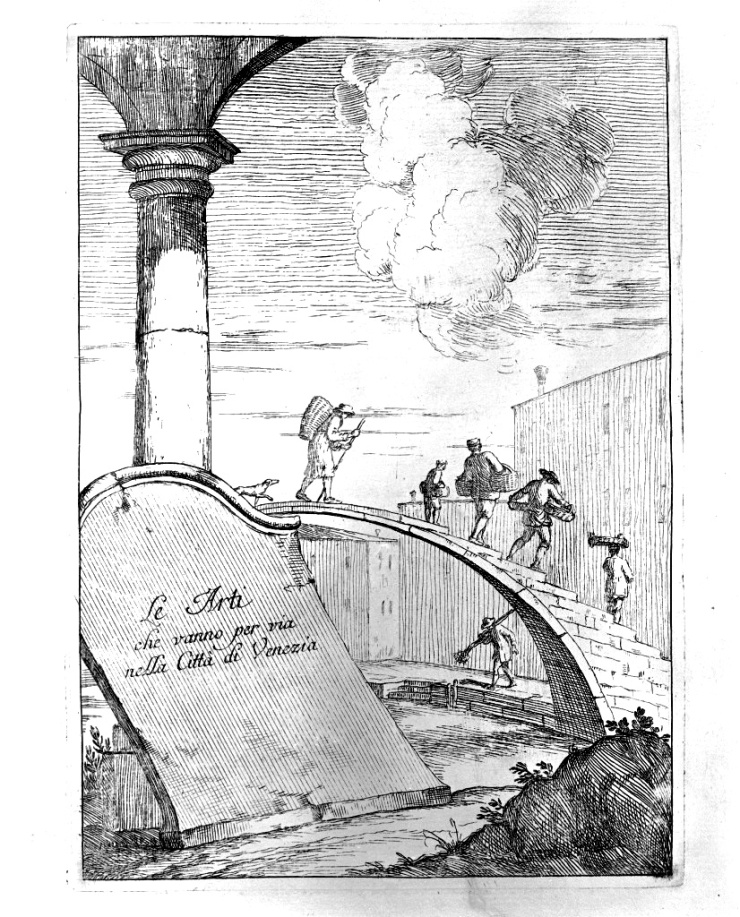The name of Gaetano Zompini probably does not mean much to many people, yet he was a great illustrator of everyday Venetian street life in the first half of the eighteenth century.
His main work, Arti che vanno per via nella città di Venezia (Trades practised in the streets of the city of Venice), which he produced between 1746 to 1754, was the first point of reference to reconstruct and describe the teeming world of street vendors, artisans, traders and labourers who filled the Venetian streets in The Laws of Time. A colourful, sonorous, odorous world that left no other trace and constituted the true palette of nuances and tones that were the real, constant, vociferous background of Venice. These are the men and women who worked outdoors, often also in the service of a society that did not deign to get its shoes dirty in the muddy streets.
Gaetano Zompini was born in Nervesa (Treviso) in 1700 and died in 1778 in Venice.
We do not know much about his biographical details, but what we know enough to frame him within a Venetian artistic and intellectual environment of great interest, animated by leading cultural figures such as Francesco Algarotti and Anton Maria Zanetti, painters including Sebastiano and Marco Ricci, Rosalba Carriera, Canaletto, Antonio Visentini, and the publisher Gian Battista Albrizzi. It is also the environment in which Catterina, the protagonist of The Laws of Time, also moves, and around which the whole novel revolves.
We are in that circle of antique dealers, artists, musicians and writers who, since the early eighteenth century, also play an important intellectual role fighting every form of conventionality in the name of rationalism. They are a group of friends who often gravitate around Joseph Smith, future British Consul at the Serenissima, merchant and banker, close follower of art world events, astute collector and client, and mediator between many fascinating personalities. His library is famous throughout Europe, especially for its architectural treatises. His home at Santi Apostoli becomes a meeting point for Venetian culture and a place where international visitors passing through the lagoon can meet Venetian patricians who are otherwise forbidden any relationship with foreign representatives. Anton Maria Zanetti, a friend of Smith and Carriera, also moves in this environment of European progressives.
Gaetano Gherardo Zompini was a painter and decorator when Anton Maria Zanetti employed him for the main purpose of making copper engravings. Zanetti was the guardian of the Public Library of San Marco, an art writer, draftsman, caricaturist and refined collector, and passionate about the technique of engraving. From the collaboration between him and Zompini came the idea of composing a collection of images of the street vendors, artisans, labourers and merchants that populate the streets of Venice, inspired by the Artisans of Bologna engravings by Annibale Carracci.
It was Zanetti who, in 1754, sponsored and directed the first edition of the Arti che vanno per via nella città di Venezia, a collection of sixty etchings representing the minor, marginal and humbler aspects of Venice. To complete the publication, Zanetti asked Dr. Questini, priest at Santa Maria Mater Domini, a friend of his and of Zompini, to compose short three verse captions to add a voice-over to each image, like a short narration in Venetian.
The first edition of the Arti che vanno per via nella città di Veneziawas followed by at least another six printings, always taken from the same plates, up to the last print run of the mid-nineteenth century, by now showing signs that the copper matrix was now visibly worn. There were also two editions with the captions in English by John Strange, writer and diplomat, appointed British Resident in Venice from 1773 to 1787.
Everyday life in eighteenth-century Venice is also beautifully staged in the paintings of Pietro Longhi and Gabriel Bella, in the views of Francesco Guardi, Bernardo Bellotto and Canaletto; but if Antonio Canal with his camera obscura gives us photographs of the city, Zompini zooms in on those streets, between the narrow alleys, onto the doorsteps of the poor and the muddy or badly-paved banks of the canals.
To conduct a good historical analysis it is necessary to refer to the sources—and the etchings by Gaetano Zompini are an extraordinary historical source, visual and not written. First of all, Zompini reminds us that Venice was not just the spectacular city of theatrical and magnificent houses on the Grand Canal. It was not just home to patrician families wrapped in brocades, satins and silk taffeta and portrayed in opulent interiors. Venice was, above all, a city of working people, who traded wholesale and retail, who carried on their valuable trades street by street in the service of everyday needs. The Zompini etchings portray common people, the common people who earn their daily bread humbly. Here the artist’s gaze is focused on these people who fill the streets, and the Venice of bell towers and three-light windows disappears. A well, a dog, a door, a wall lightly set the scene for the actions and actors represented: children, women, men, old people who have left no trace in history, have written no treatises or documents nor played prominent roles. Enjoy yourself conjuring up the colours of their clothes, their smells, the sound of their voices and their dialect. They formed the kaleidoscopic mosaic of Venetian street life. The rest does not even have to be imagined, Zompini tells us. It is enough to look carefully at every single figure he presents to find each one of those colours.
Andrea Perego
Le Arti che vanno per via nella città di Venezia was republished in 2009 by Filippi Editore, Venice, with an introduction by Andrea Perego.
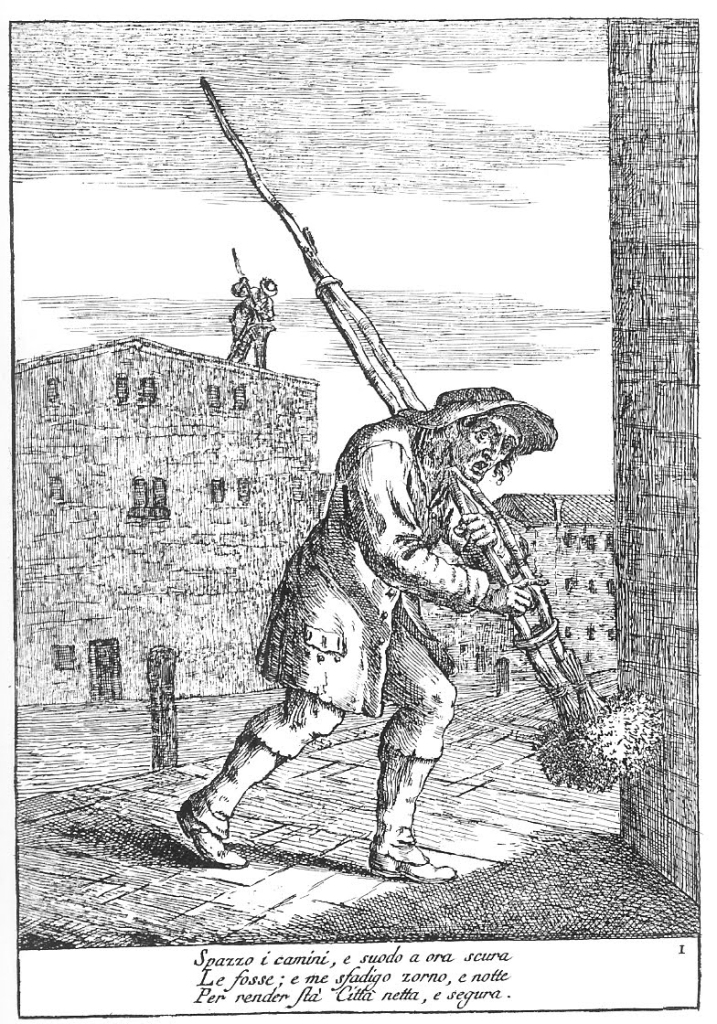
Original Venetian text:
Spazzo i camini, e svodo a ora scura
Le fosse; e me sfadigo zorno e notte
Per render stà città netta, e segura.
From Le arti che vanno per via nella città di Venezia, 1746-1754
Etching by Gaetano Zompini
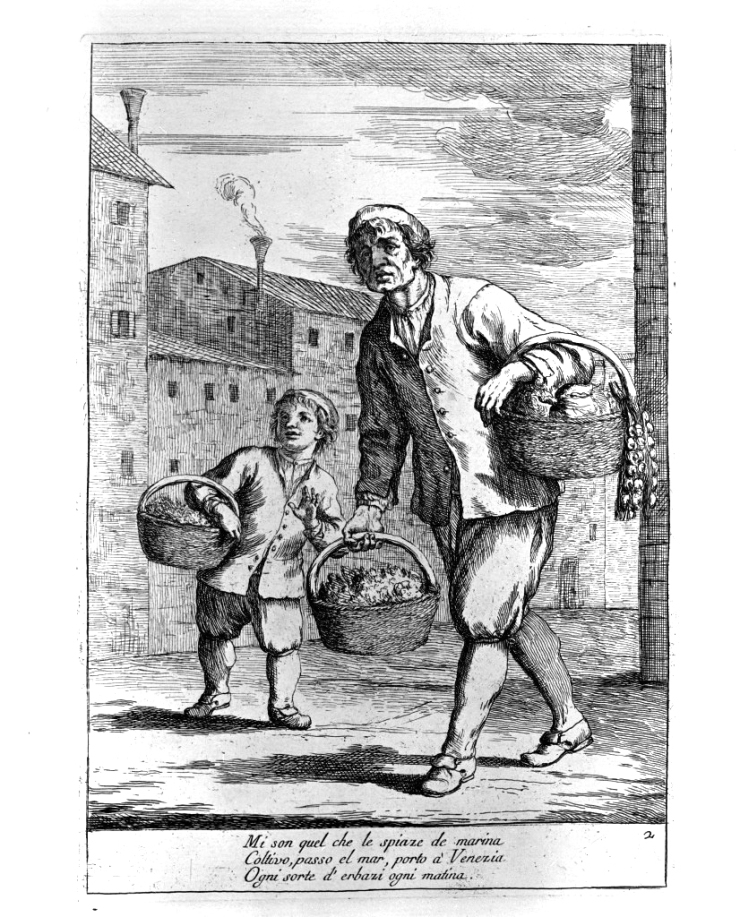
Plate 2: The salad pedlar and a young boy helping.
Original Venetian text:
Mi son quel che le spiaze de marina
Coltivo, passo el mar, porto à Venezia
Ogni sorte d’erbazi ogni matina.
From Le arti che vanno per via nella città di Venezia, 1746-1754
Etching by Gaetano Zompini
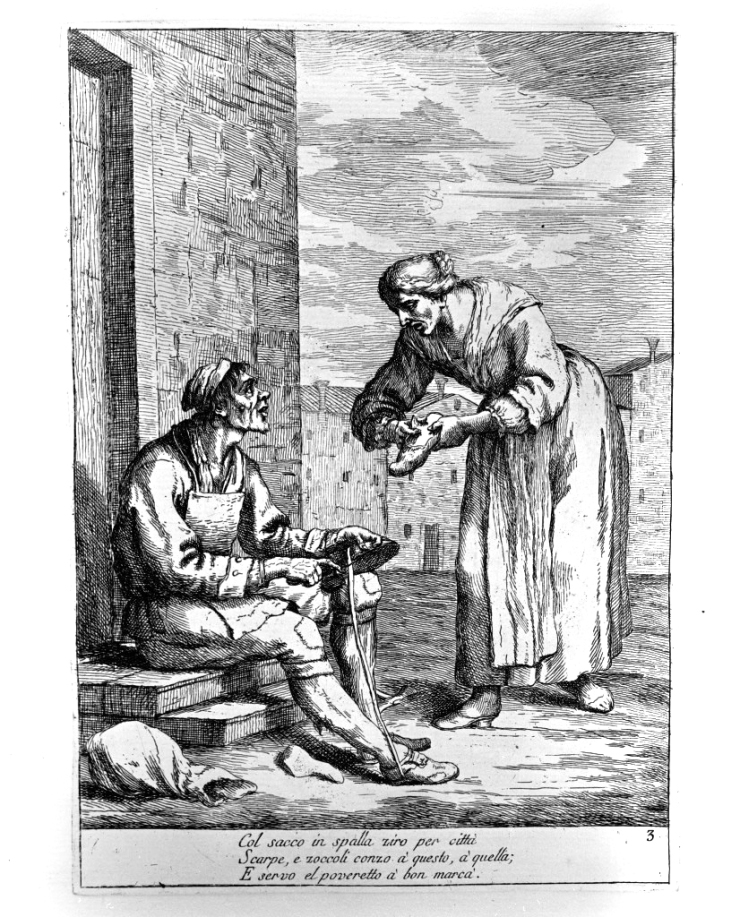
Plate 3: The clog and shoe cleaner and repairer with his customer.
Original Venetian text:
Col sacco in spalla ziro per città
Scarpe, e zoccoli conzo à questo, à quella;
E servo el poveretto à bon marcà.
From Le arti che vanno per via nella città di Venezia, 1746-1754
Etching by Gaetano Zompini
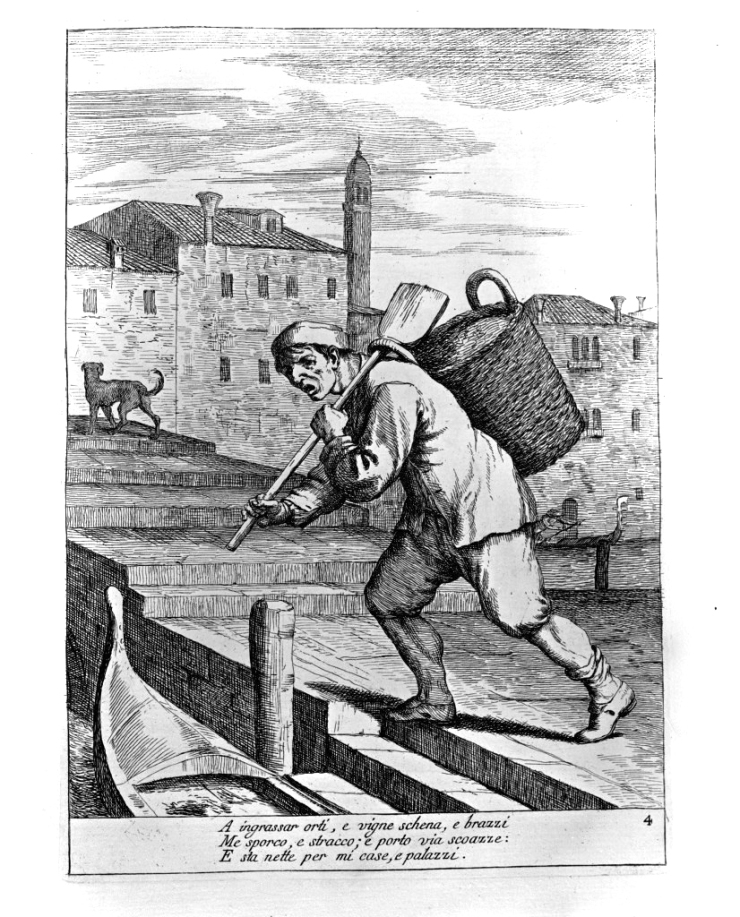
Plate 4: The household rubbish collector.
Original Venetian text:
A ingrassar orti, e vigne schena, e brazzi
Me sporco, e stracco; e porto via scoazze:
E sta nette per mi case, e palazzi.
From Le arti che vanno per via nella città di Venezia, 1746-1754
Etching by Gaetano Zompini
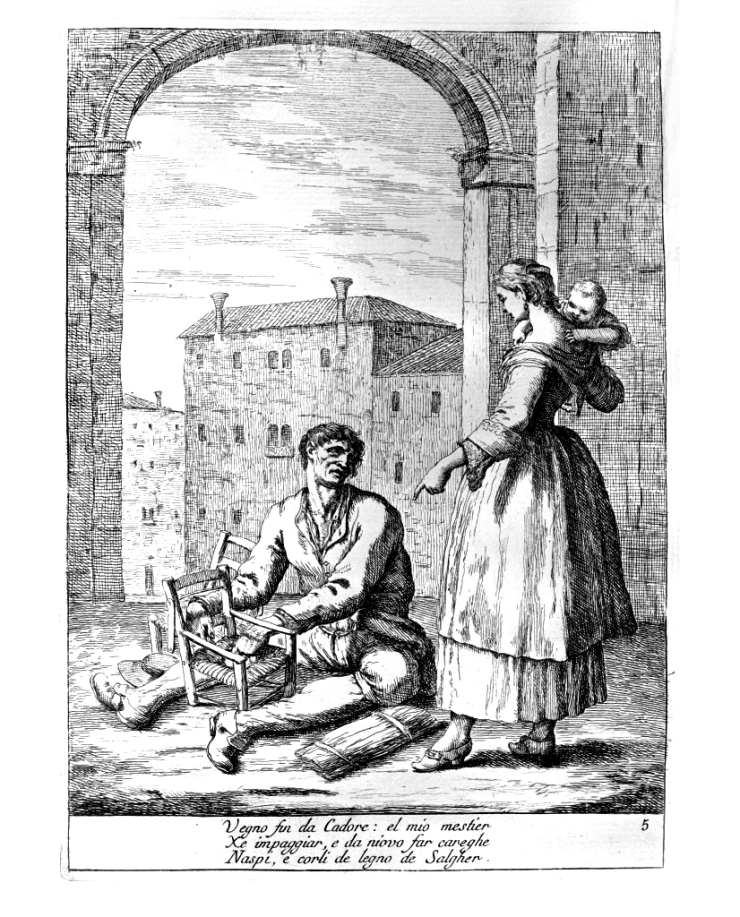
Plate 5: The chair restorer from Cadore renewing the rushes in a child’s seat.
Original Venetian text:
Vegno fin da Cadore: el mio mestier
Xe impaggiar, e da niovo far careghe
Naspi, e corli de legno de Salgher.
From Le arti che vanno per via nella città di Venezia, 1746-1754
Etching by Gaetano Zompini
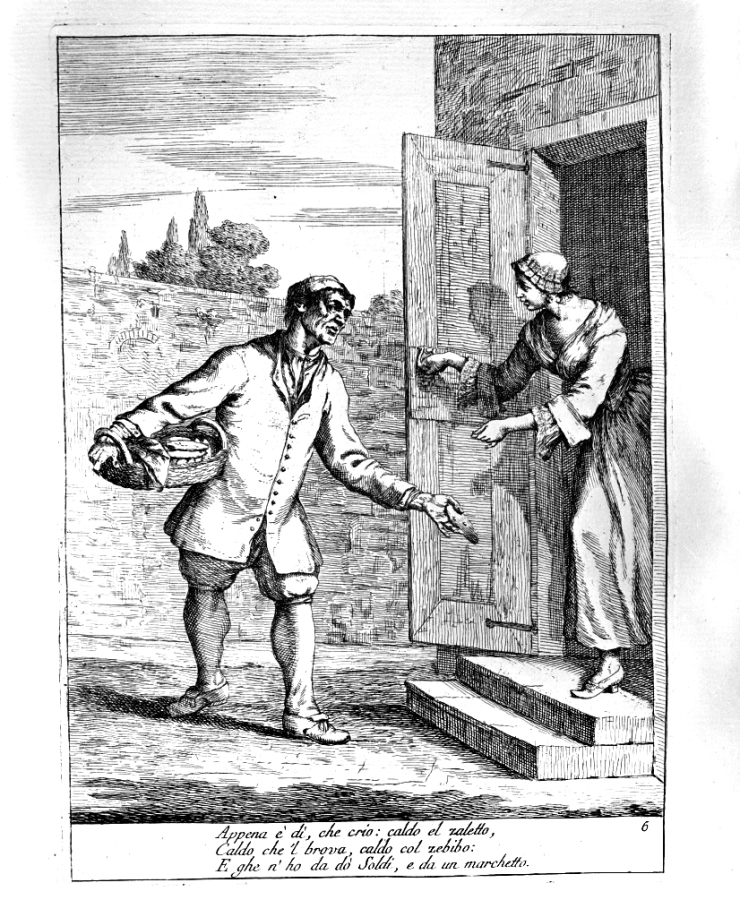
Plate 6: The door-to-door biscuit salesman.
Original Venetian text:
Appena è dì, che crio: caldo el zaletto,
Caldo che ‘l brova, caldo col zebibo:
E ghe n’ho da dò soldi, e da un marchetto.
From Le arti che vanno per via nella città di Venezia, 1746-1754
Etching by Gaetano Zompini
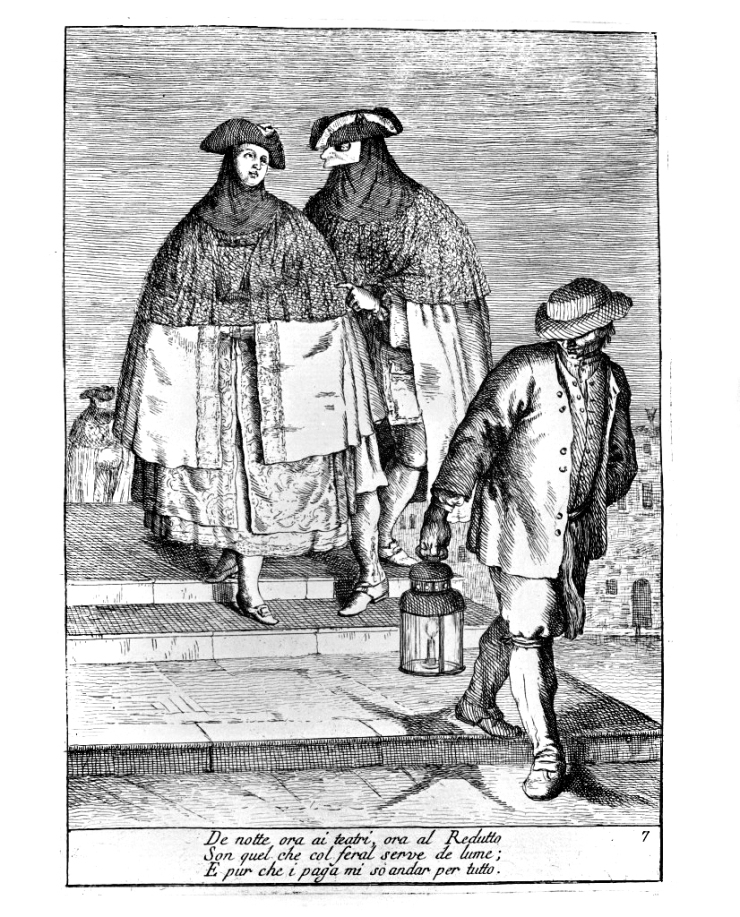
Plate 7: The codega: lantern bearer.
Original Venetian text:
De notte, ora ai teatri, ora al Redutto
Son quel che col feral serve de lume;
E pur che i paga mi so andar per tutto.
From Le arti che vanno per via nella città di Venezia, 1746-1754
Etching by Gaetano Zompini
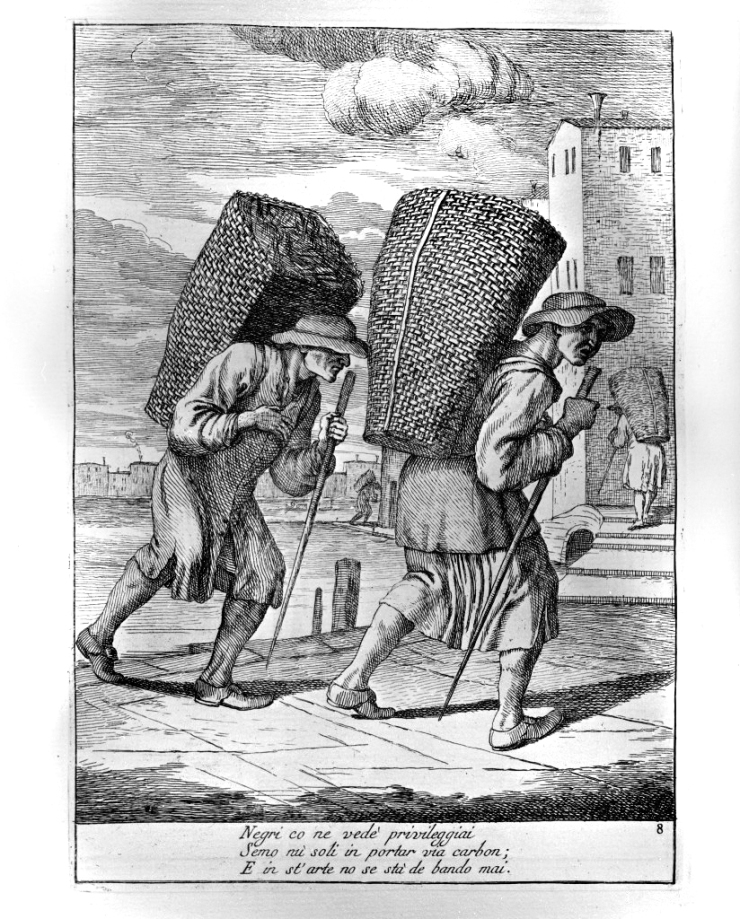
Plate 8: The coal delivery men.
Original Venetian text:
Negri co ne vedè privileggiai
Semo nù soli in portar via carbon;
E in st’arte non se stà de bando mai.
From Le arti che vanno per via nella città di Venezia, 1746-1754
Etching by Gaetano Zompini
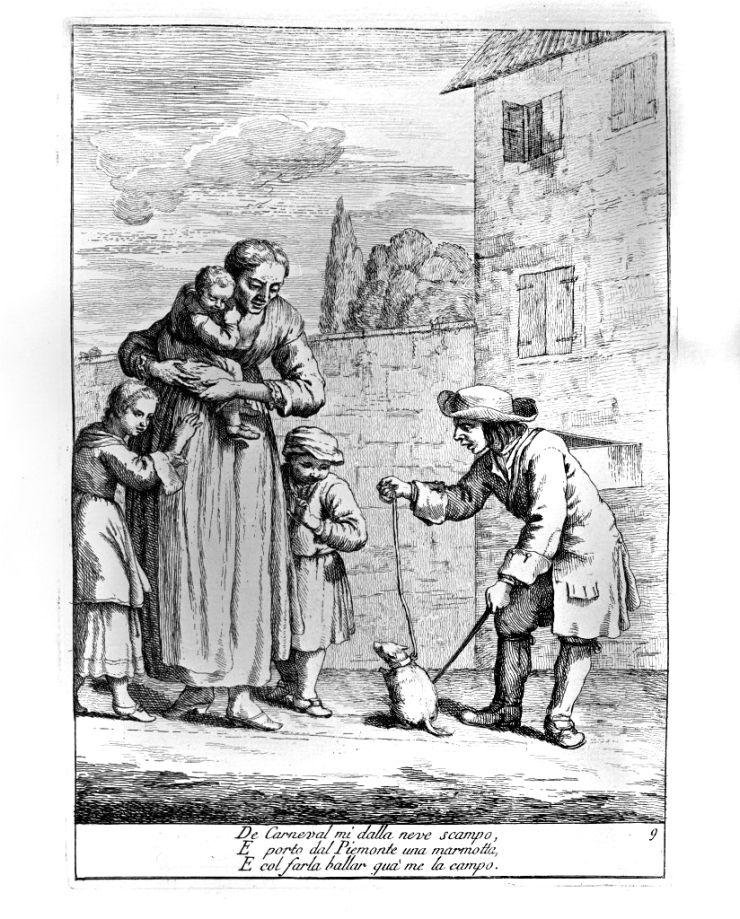
Plate 9: The street entertainer from Piedmont, with a performing marmot.
Original Venetian text:
De Carneval mi dalla neve scampo,
E porto dal Piemonte una marmotta,
E col farla ballar quà me la campo.
From Le arti che vanno per via nella città di Venezia, 1746-1754
Etching by Gaetano Zompini
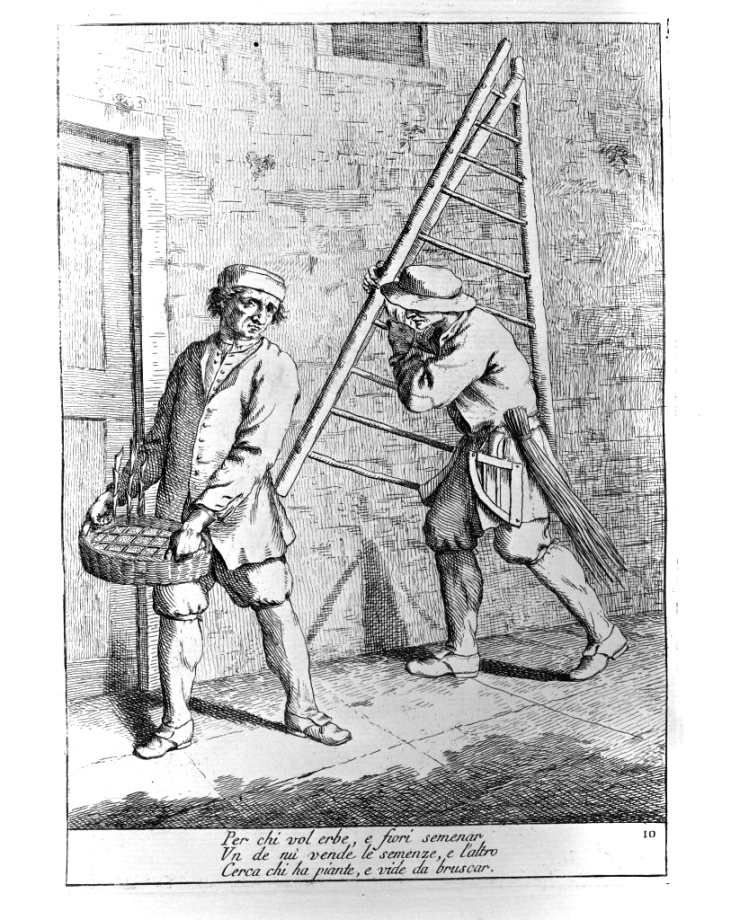
Plate 10: The door-to-door seed pedlars with seeds and a ladder to use when pruning trees.
Original Venetian text:
Per chi vol erbe, e fiori semenar
Un de nù vende le semenze, e l’altro
Cerca chi ha piante, e vide da bruscar.
From Le arti che vanno per via nella città di Venezia, 1746-1754
Etching by Gaetano Zompini
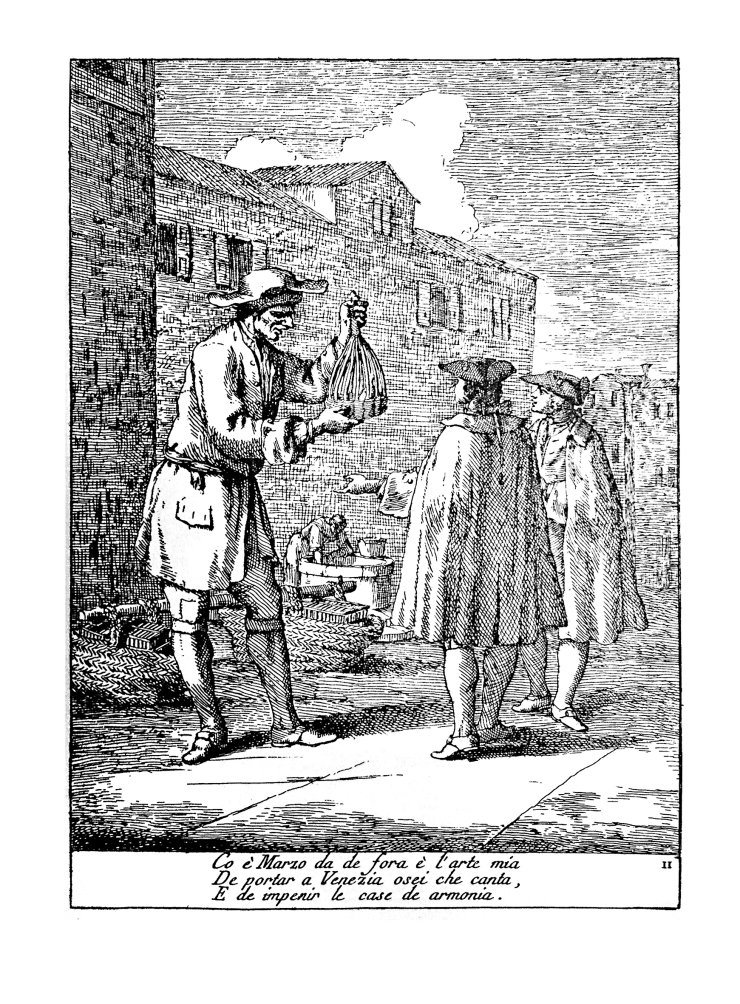
Original Venetian text:
Co è Marzo da de fora è l’arte mia
De portar a Venezia osei che canta,
E de impenir le case de armonia.
From Le arti che vanno per via nella città di Venezia, 1746-1754
Etching by Gaetano Zompini
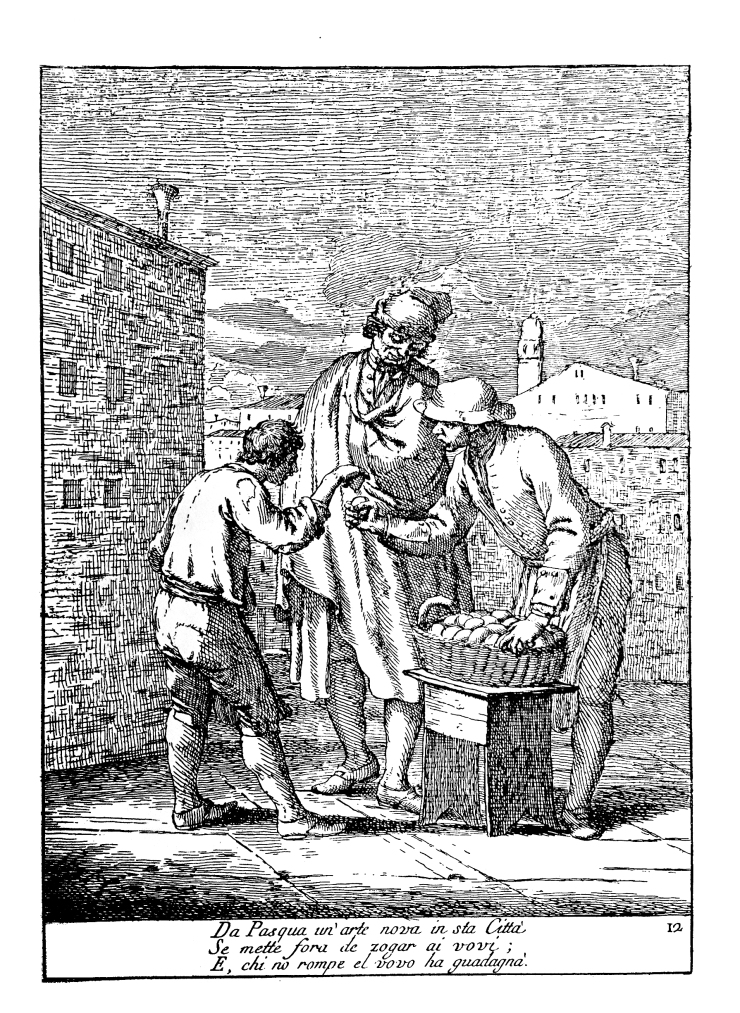
Plate 12: The egg man at Easter, with a street game: whoever doesn’t break the egg, wins.
Original Venetian text:
Da Pasqua un’arte nova in sta Città
Se mette fora de zogar ai vovi;
E, chi no rompe el vovo ha guadagnà.
From Le arti che vanno per via nella città di Venezia, 1746-1754
Etching by Gaetano Zompini
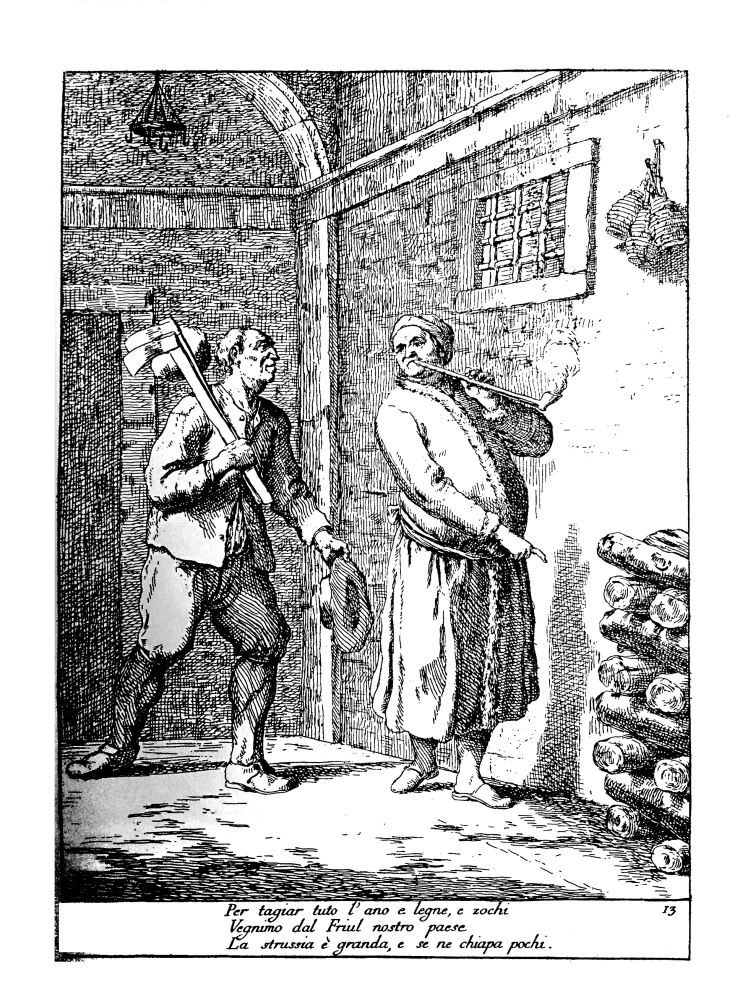
Plate 13: The woodcutter arrives from Friuli to cut the wood.
Original Venetian text:
Per tagiar tuto l’ano e legne, e zoghi
Vegnimo da Friul nostro paese
La strussia è granda, e se ne ciapa pochi.
From Le arti che vanno per via nella città di Venezia, 1746-1754
Etching by Gaetano Zompini
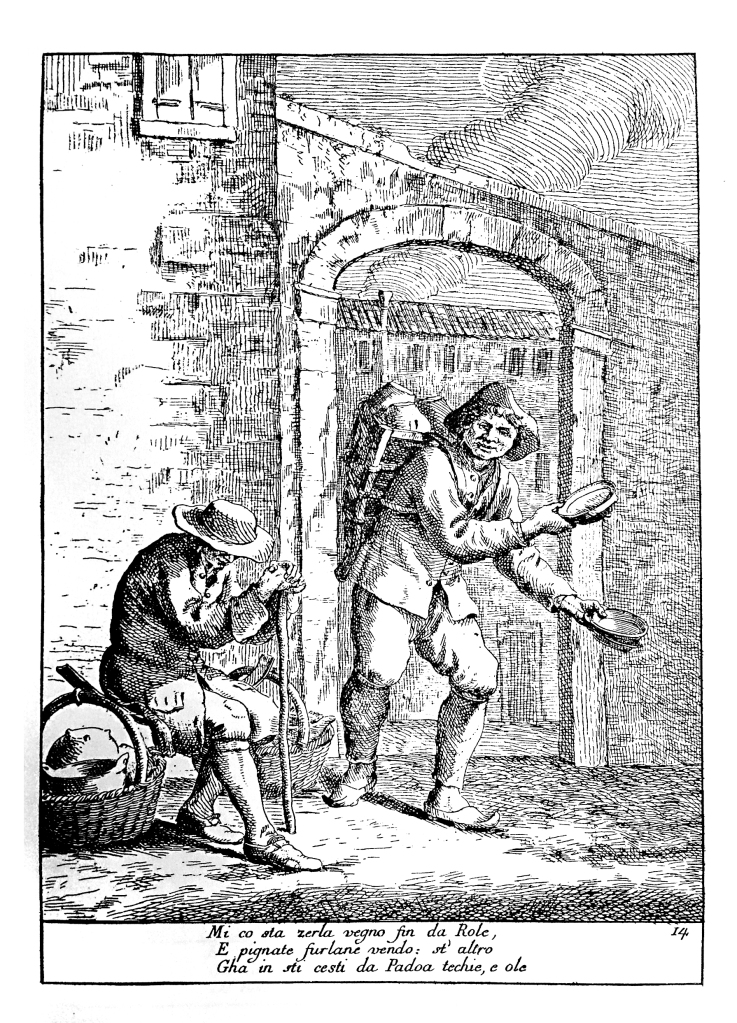
Plate 14: The door-to-door pots and pans pedlars from Friuli and Padua.
Original Venetian text:
Mi co sta zerla vegno fin da Role,
E pignate furlane vendo: st’altro
Gha in sti cesti da Padoa techie, e ole.
From Le arti che vanno per via nella città di Venezia, 1746-1754
Etching by Gaetano Zompini
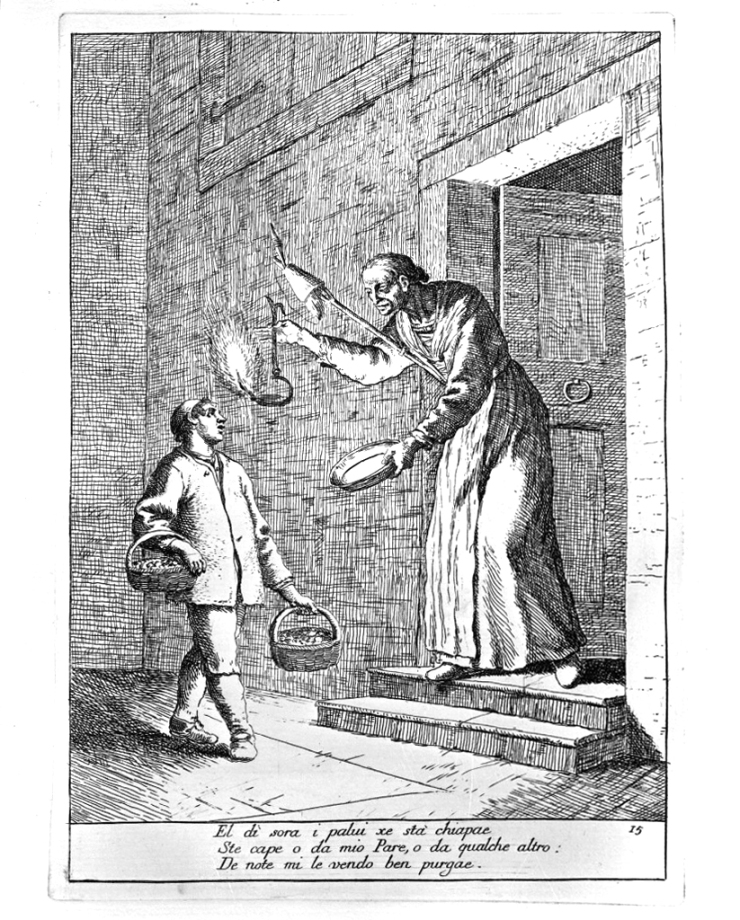
Plate 15: The evening sale of mussels that have been harvested and already cleaned by soaking.
Original Venetian text:
El dì sora i palui xe stà chiapae
Ste cape o da mio Pare, o da qualche altro:
De note mi le vendo ben purgae.
From Le arti che vanno per via nella città di Venezia, 1746-1754
Etching by Gaetano Zompini
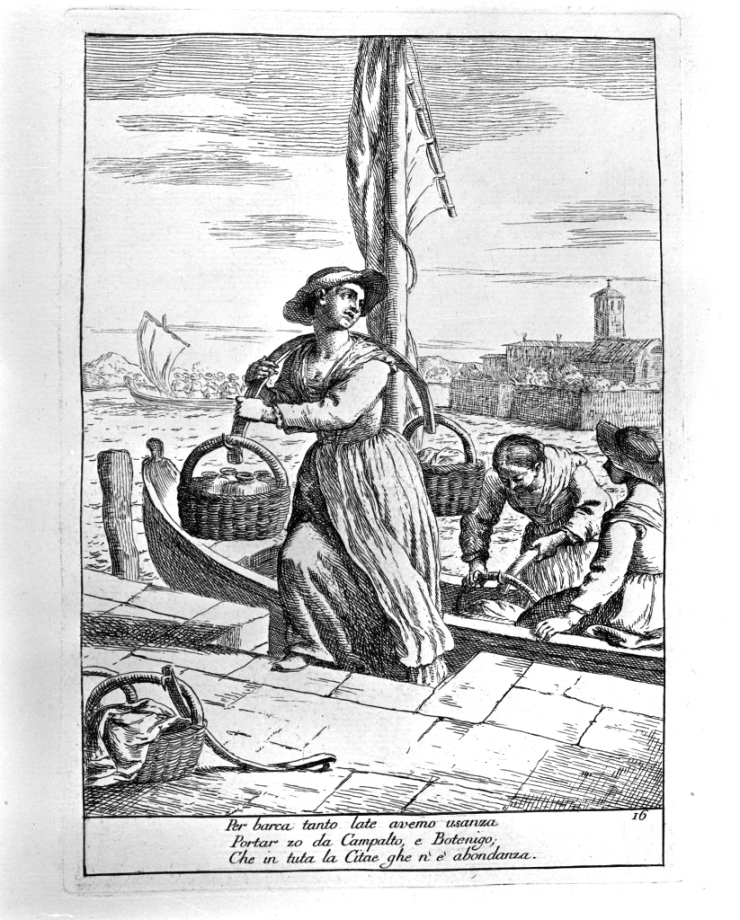
Plate 16: The milk delivery women from the country.
Original Venetian text:
Per barca tanto late avemo usanza
Portar zo da Campalto, e Botenigo,
Che in tuta la Citae ghe n’è abondanza.
From Le arti che vanno per via nella città di Venezia, 1746-1754
Etching by Gaetano Zompini
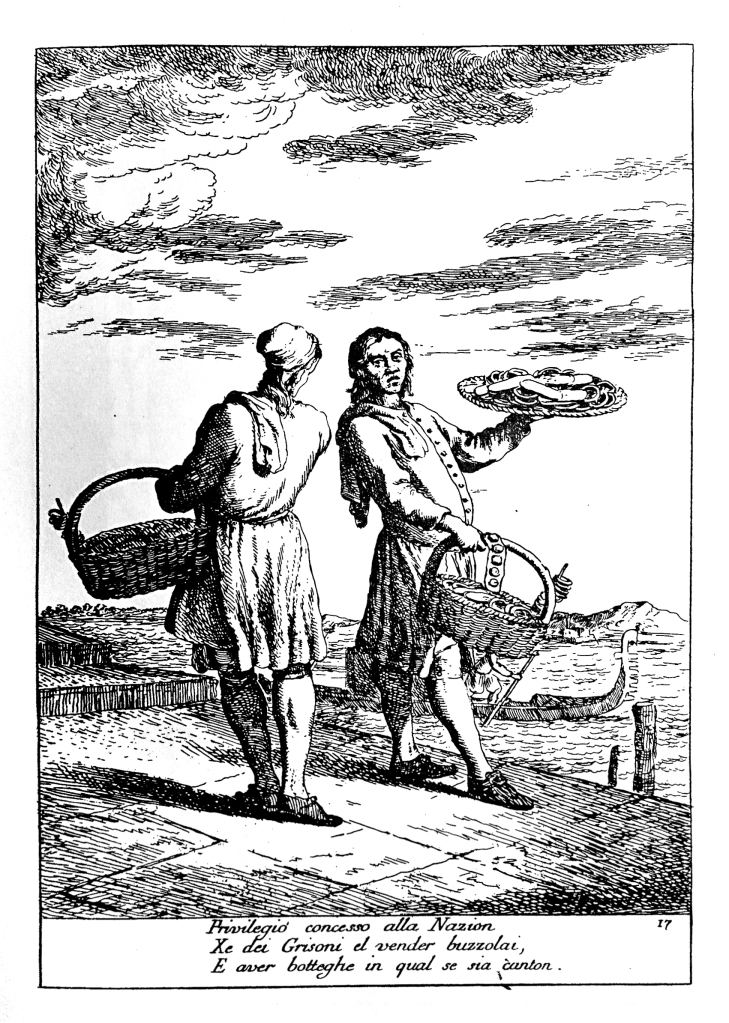
Plate 17: The licenced bussolà cookie vendors.
Original Venetian text:
Privilegio concesso alla Nazion
Xe dei Grisoni el vender buzzolai,
E aver botteghe in qual se sia canton.
From Le arti che vanno per via nella città di Venezia, 1746-1754
Etching by Gaetano Zompini
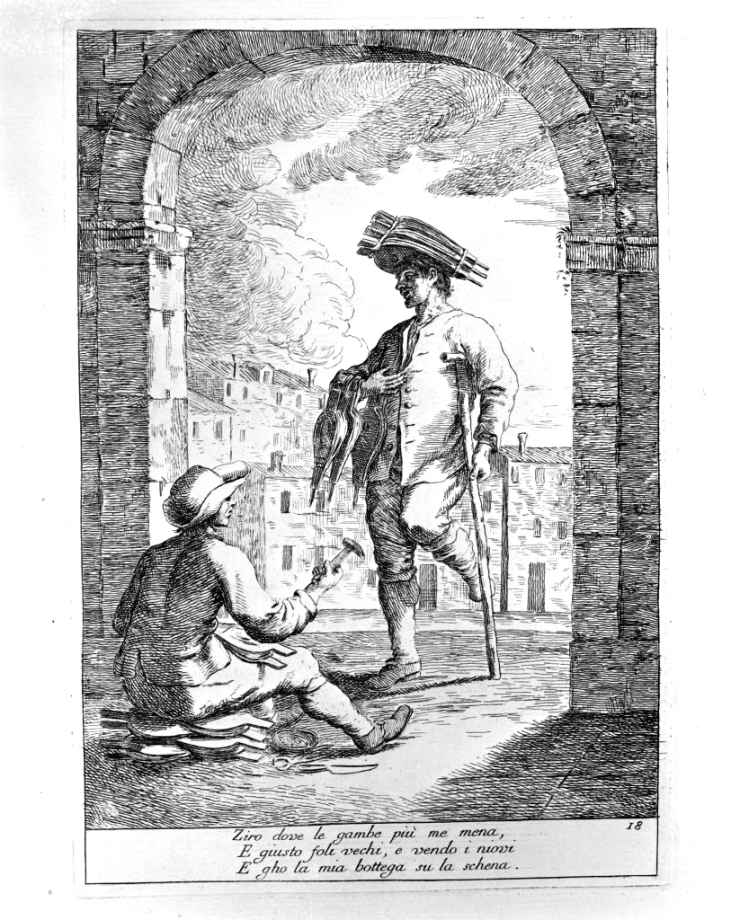
Plate 18: The bellows repairer and vendor.
Original Venetian text:
Ziro dove le gambe più me mena,
E giusto foli vechi, e vendo i niovi
E gho la mia bottega su la schena.
From Le arti che vanno per via nella città di Venezia, 1746-1754
Etching by Gaetano Zompini
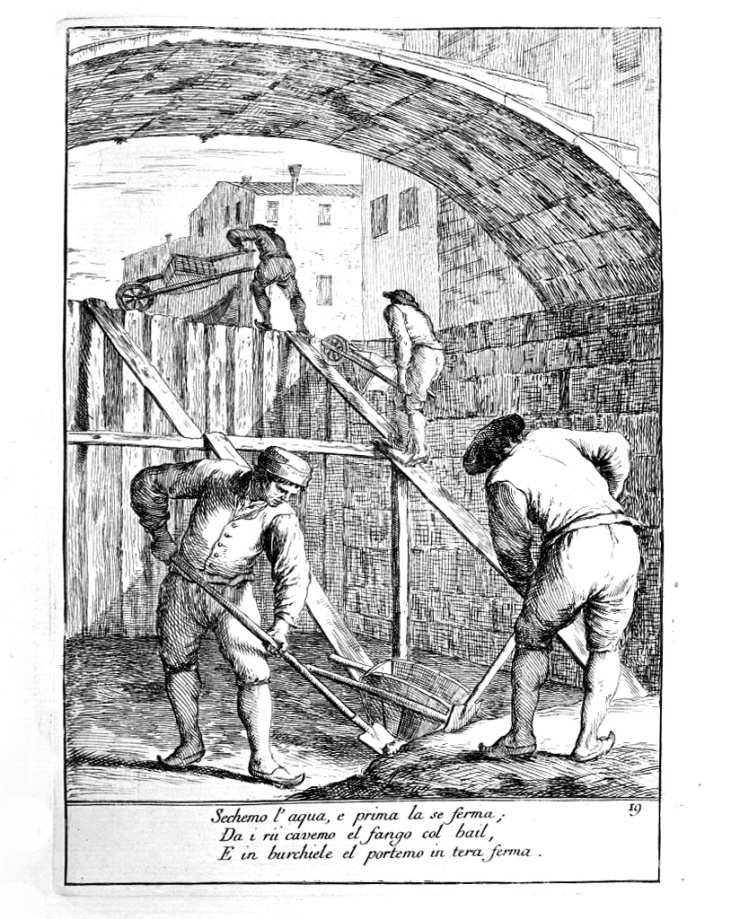
Plate 19: The canal dredgers.
Original Venetian text:
Sechemo l’acqua, e prima la se ferma;
Da i rii cavemo el fango col bail,
E in burchiele el portemo in tera ferma.
From Le arti che vanno per via nella città di Venezia, 1746-1754
Etching by Gaetano Zompini
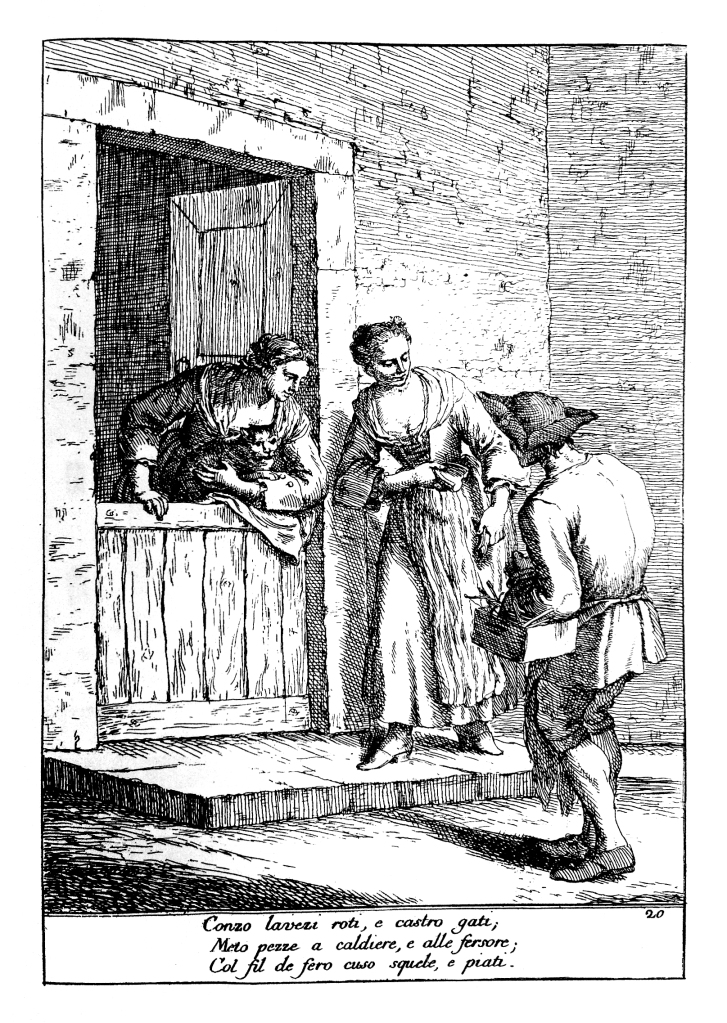
Plate 20: The Jack-of-all-trades, including repairing cooking pots and gelding cats.
Original Venetian text:
Conzo lavezi roti, e castro gati;
Meto peze a caldiere, e alle fersore;
Col fil de fero cuso squele, e piati.
From Le arti che vanno per via nella città di Venezia, 1746-1754
Etching by Gaetano Zompini
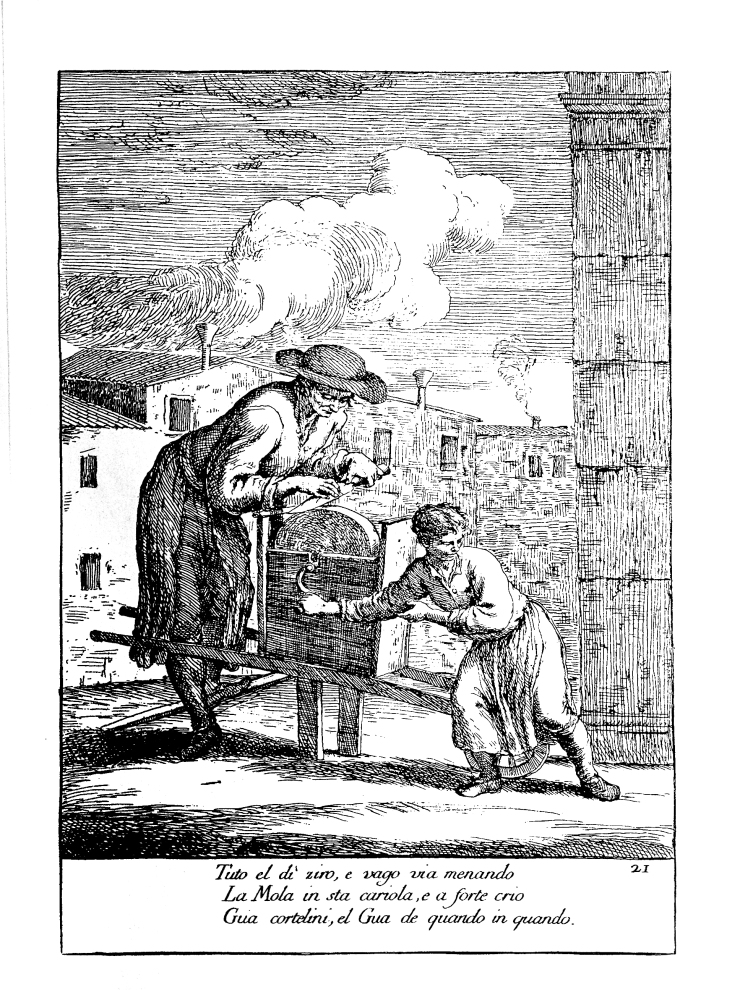
Plate 21: The knife grinder and his assistant.
Original Venetian text:
Tuto el dì ziro, e vago via menando
La Mola in sta cariola, e a forte crio
Gua cortelini, el Gua de quando in quando.
From Le arti che vanno per via nella città di Venezia, 1746-1754
Etching by Gaetano Zompini
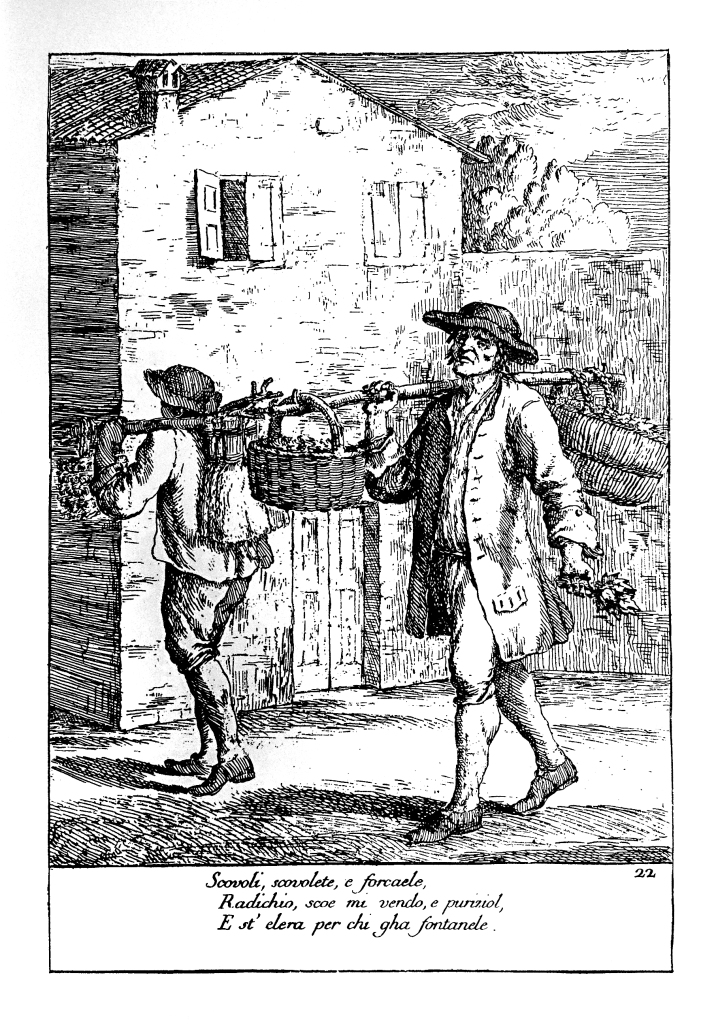
Plate 22: The Broom and vegetable pedlars.
Original Venetian text:
Scovoli, scovolete, e forcaele,
Radichio, scoe mi vendo, e puriziol,
E st’elera per chi gha fontanele.
From Le arti che vanno per via nella città di Venezia, 1746-1754
Etching by Gaetano Zompini
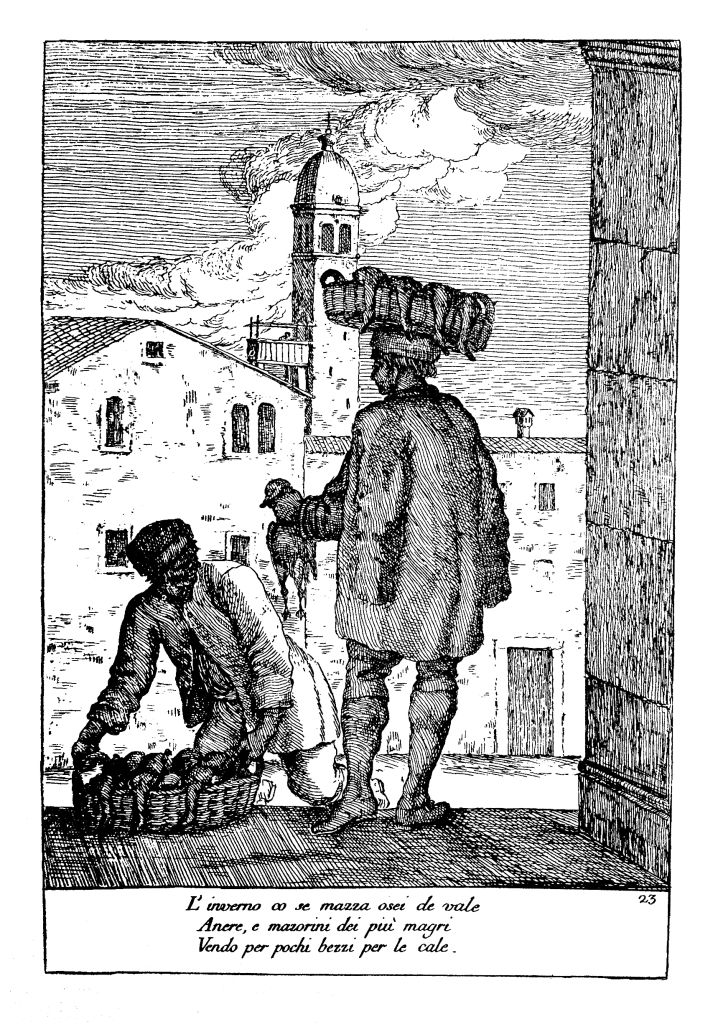
Plate 23: The game-bird pedlars.
Original Venetian text:
L’inverno co se mazza osei de vale
Anere, e mazorini dei più magri
Vendo per pochi bezzi per le cale.
From Le arti che vanno per via nella città di Venezia, 1746-1754
Etching by Gaetano Zompini
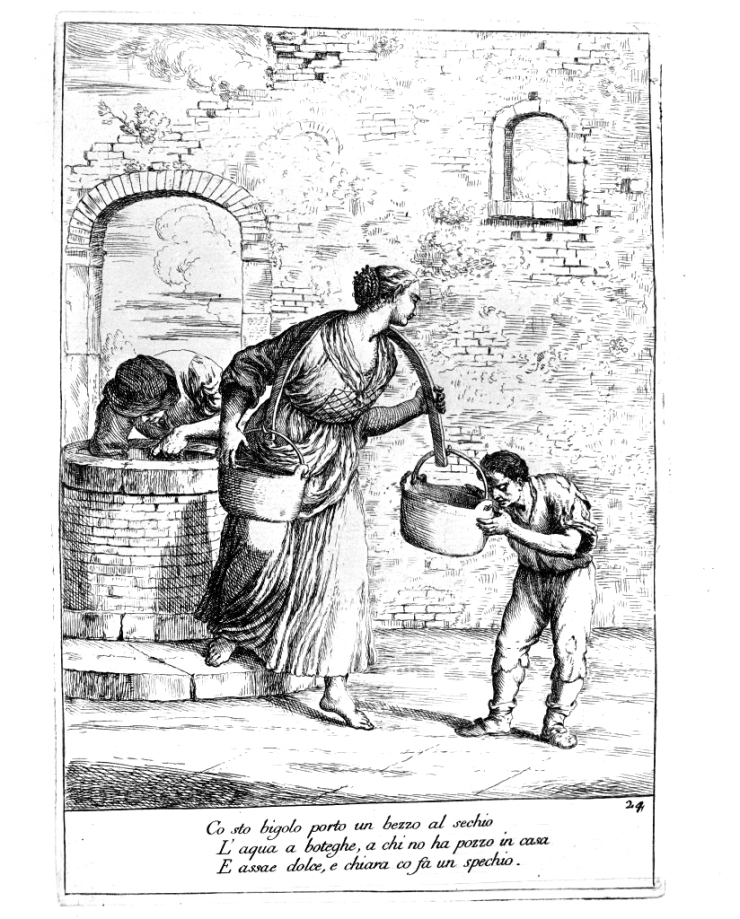
Plate 24: The water bearer restocks from the public well.
Original Venetian text:
Co sto bigolo porto un bezzo al sechio
L’aqua a boteghe, a chi no ha pozzo in casa
E assae dolce, e chiara co fa un spechio.
From Le arti che vanno per via nella città di Venezia, 1746-1754
Etching by Gaetano Zompini
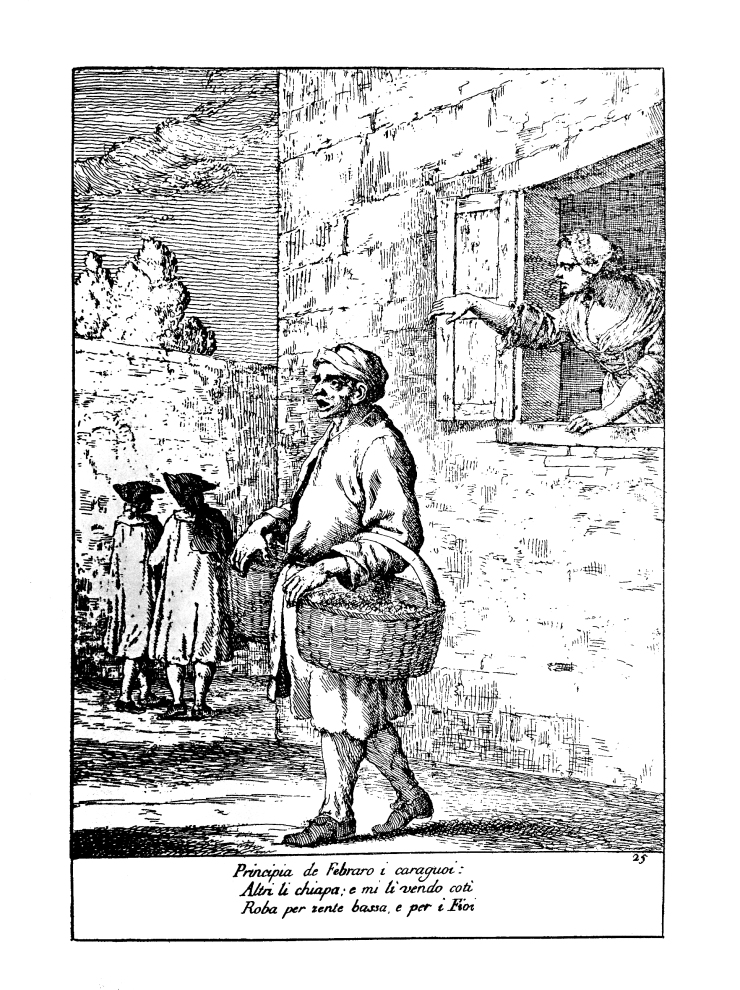
Plate 25: The cooked snail pedlar.
Original Venetian text:
Principia de Febraro i caraguoi:
Altri li chiapa: e mi li vendo coti
Roba per zente bassa, e per i Fioi.
From Le arti che vanno per via nella città di Venezia, 1746-1754
Etching by Gaetano Zompini
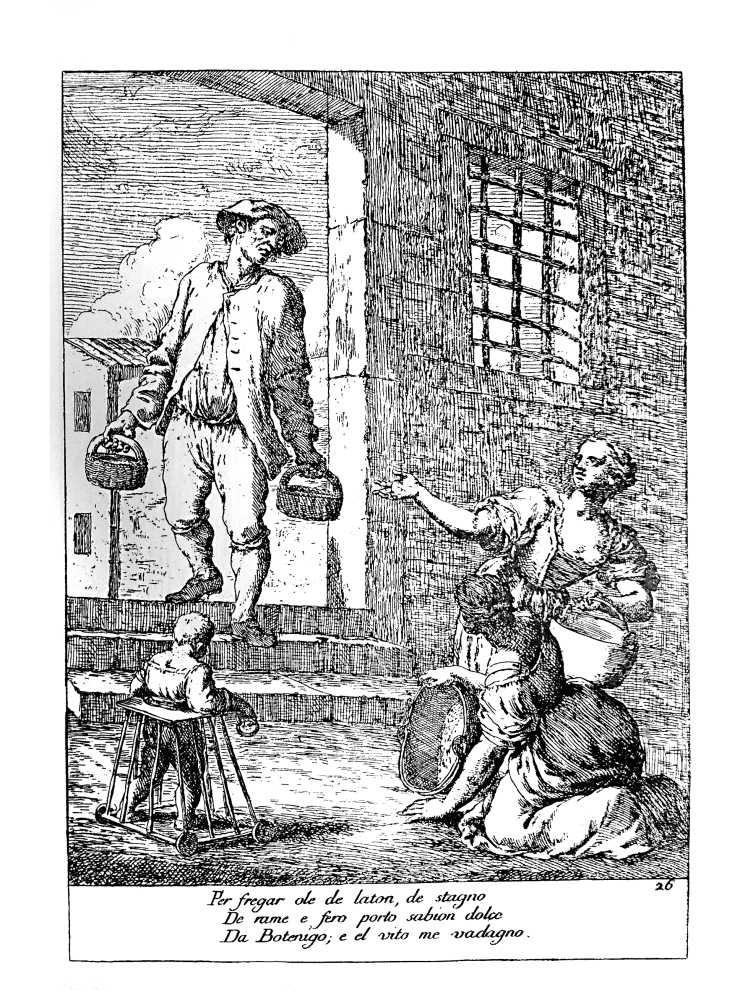
Plate 26: The metal (copper and iron) cleaner from Bottenigo.
Original Venetian text:
Per fregar ole de laton, de stagno
De rame e fero porto sabion dolce
Da Botenigo; e el vito me vadagno.
From Le arti che vanno per via nella città di Venezia, 1746-1754
Etching by Gaetano Zompini
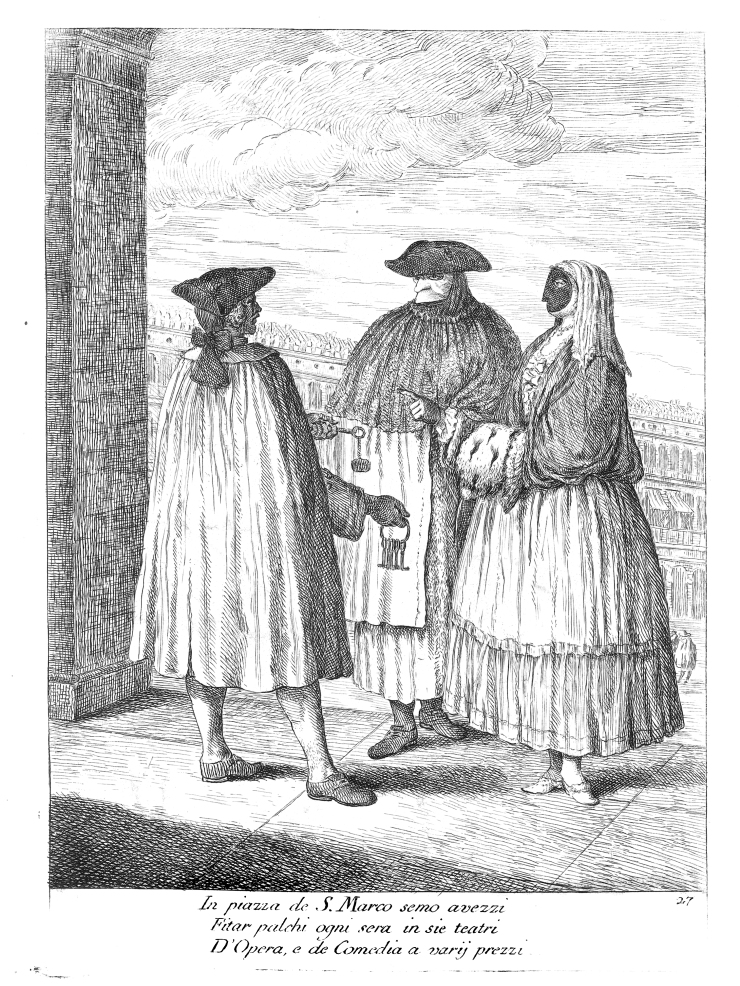
Plate 27: The theatre box keeper, handing over the keys.
Original Venetian text:
In piazza de S. Marco semo avezzi
Fitar palchi ogni sera in sie teatri
D’Opera, e de Comedia a varij prezzi.
From Le arti che vanno per via nella città di Venezia, 1746-1754
Etching by Gaetano Zompini
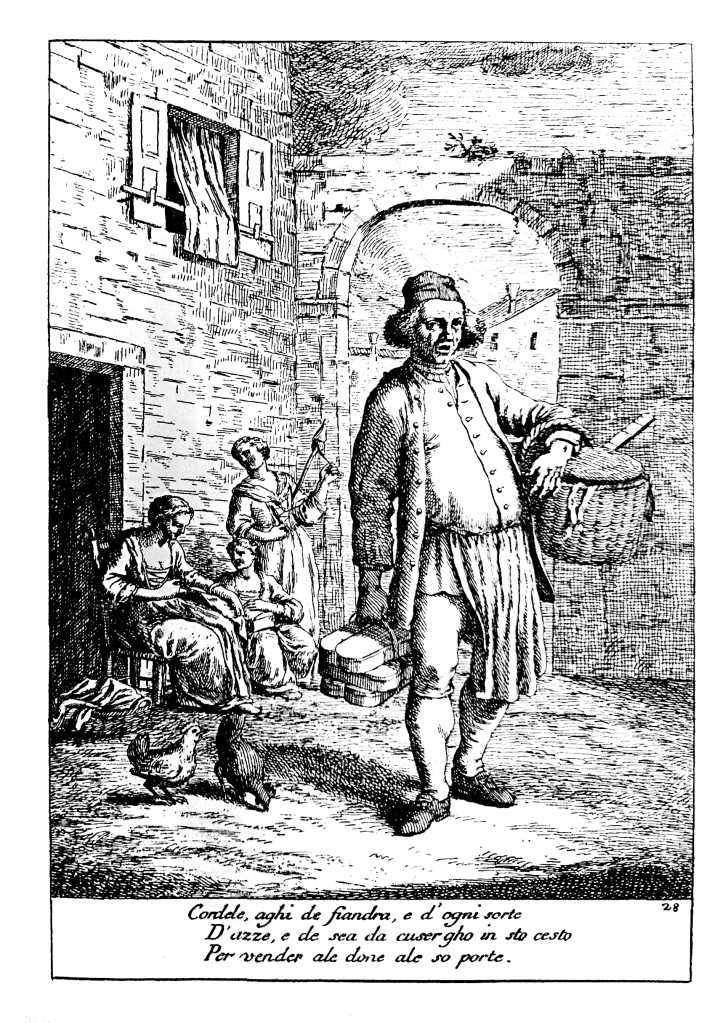
Plate 28: The door-to-door haberdasher.
Original Venetian text:
Cordele, aghi de Fiandra, e d’ogni sorte
D’azze, e de sea da cuser gho in sto cesto
Per vender ale done ale so porte.
From Le arti che vanno per via nella città di Venezia, 1746-1754
Etching by Gaetano Zompini
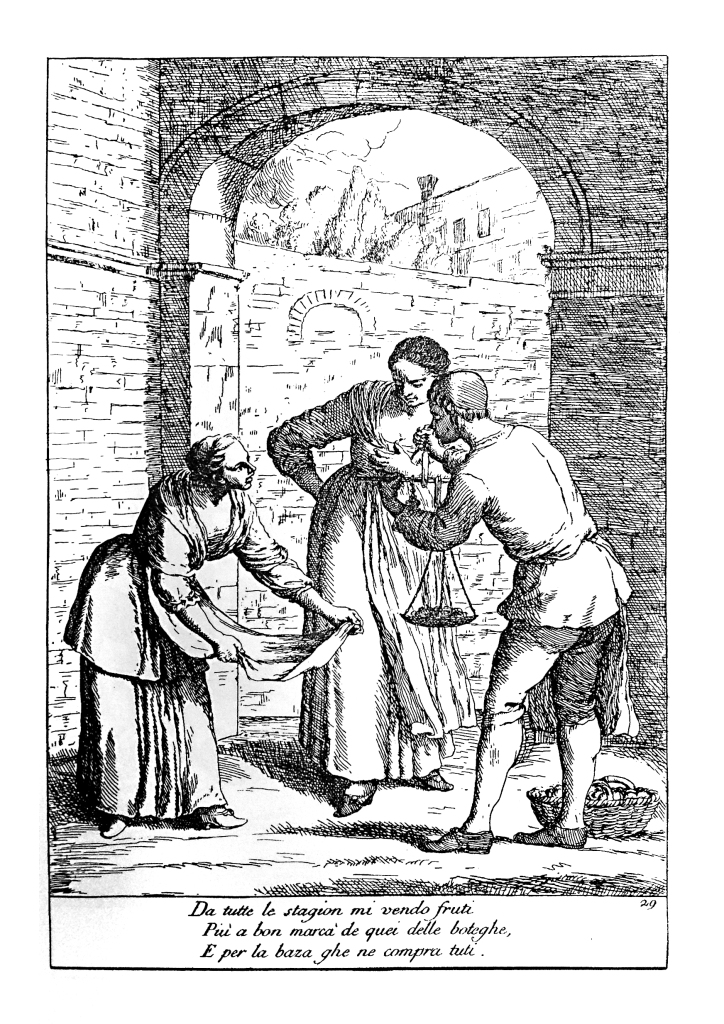
Plate 29: The door-to-door fruiterer.
Original Venetian text:
Da tutte le stagion mi vendo fruti
Più a bon marcà de quei delle boteghe,
E per la baza ghe ne compra tuti.
From Le arti che vanno per via nella città di Venezia, 1746-1754
Etching by Gaetano Zompini
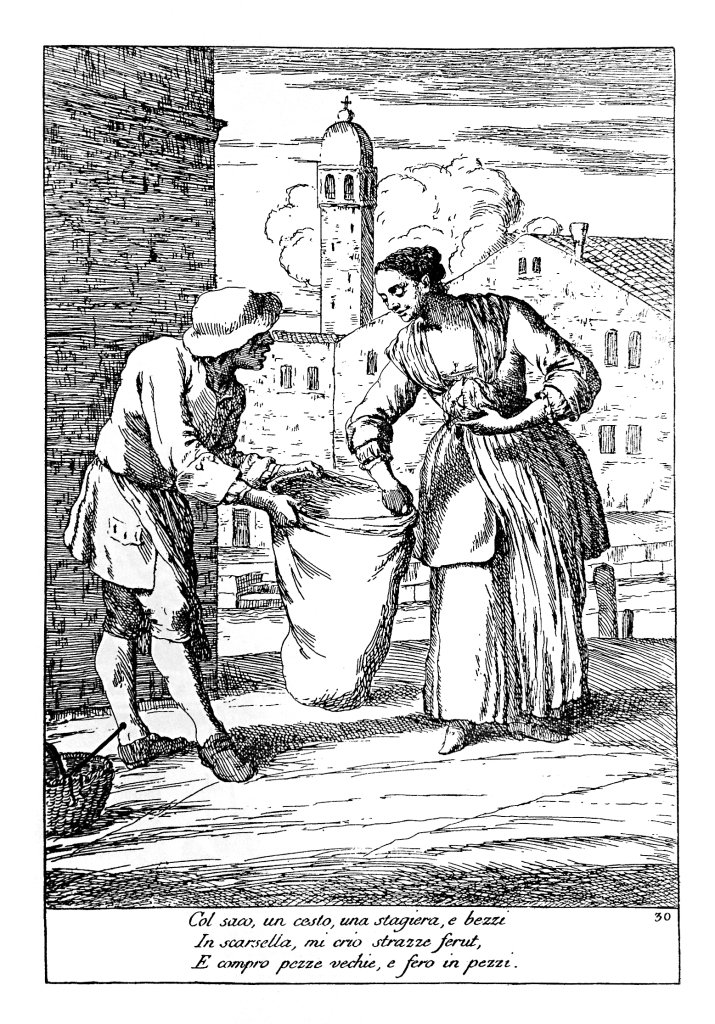
Plate 30: The rag and bone man.
Original Venetian text:
Col saco, un cesto, una stagiera, e bezzi
In scarsella, mi crio strazze ferut,
E compro pezze vechie, e fero in pezzi.
From Le arti che vanno per via nella città di Venezia, 1746-1754
Etching by Gaetano Zompini
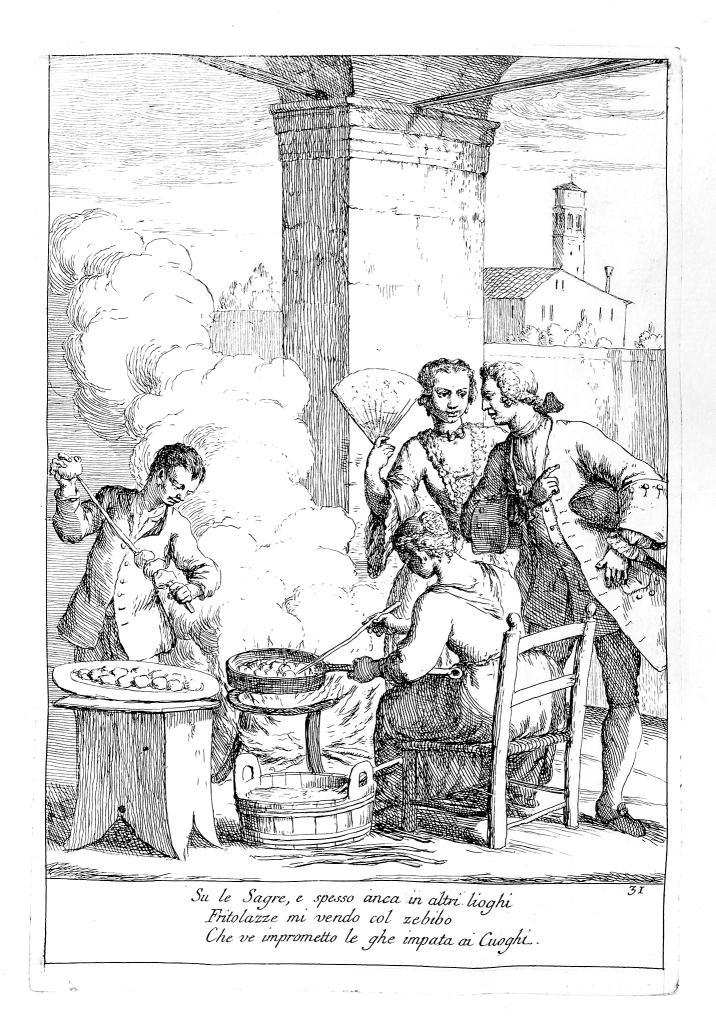
Plate 31: The fritter maker and vendor.
Original Venetian text:
Su le sagre, e spesso anca in altri lioghi
Fritolazze mi vendo col zebibo
Che ve imprometto le ghe impata ai cuoghi.
From Le arti che vanno per via nella città di Venezia, 1746-1754
Etching by Gaetano Zompini
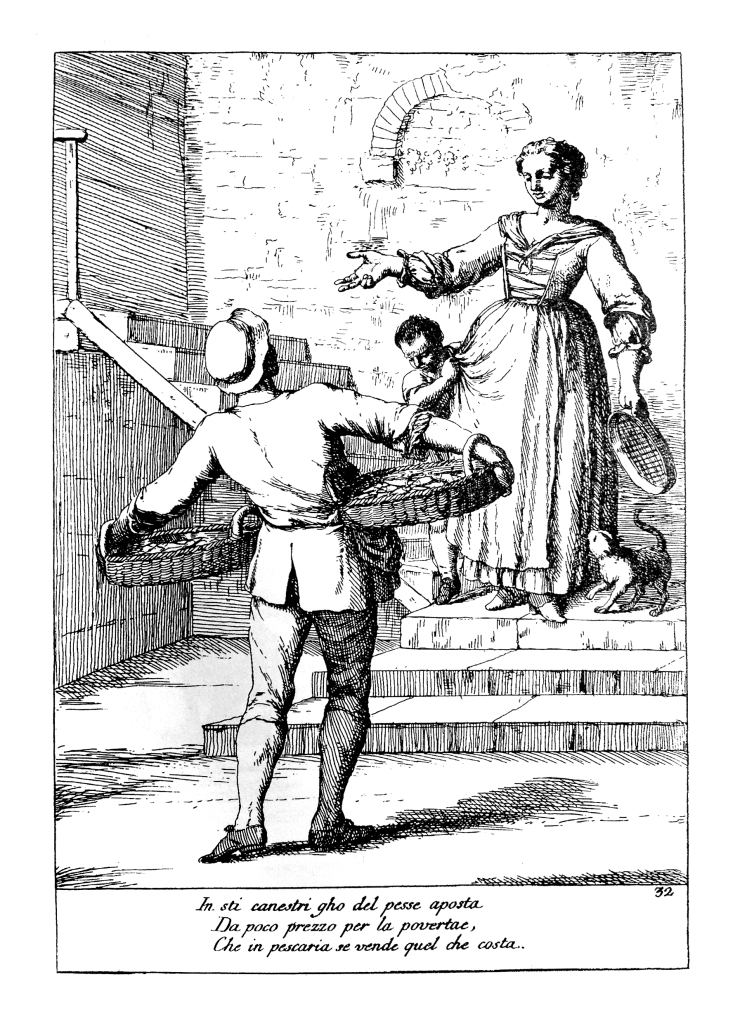
Plate 32: The cut-price fishmonger.
Original Venetian text:
In sti canestri gho del pesse aposta
Da poco prezzo per la povertae,
Che in pescaria se vende quel che costa.
From Le arti che vanno per via nella città di Venezia, 1746-1754
Etching by Gaetano Zompini
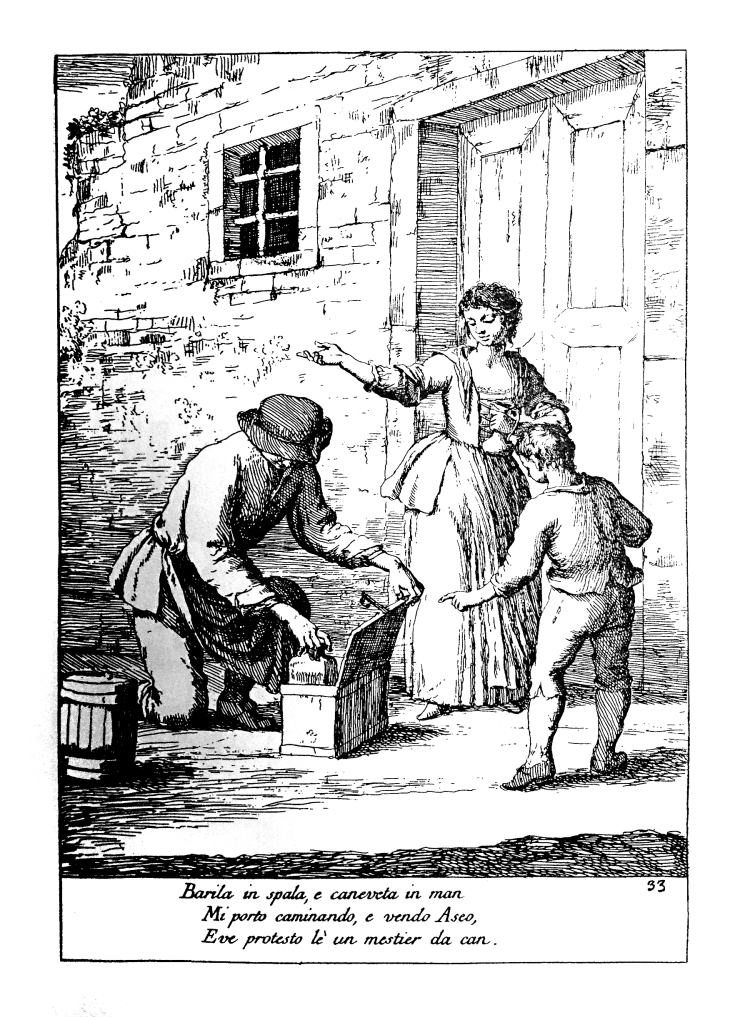
Plate 33: The strolling vinegar seller.
Original Venetian text:
Barila in spala, e canaveta in man
Mi porto caminando, e vendo Aseo,
E ve protesto lè un mestier da can.
From Le arti che vanno per via nella città di Venezia, 1746-1754
Etching by Gaetano Zompini
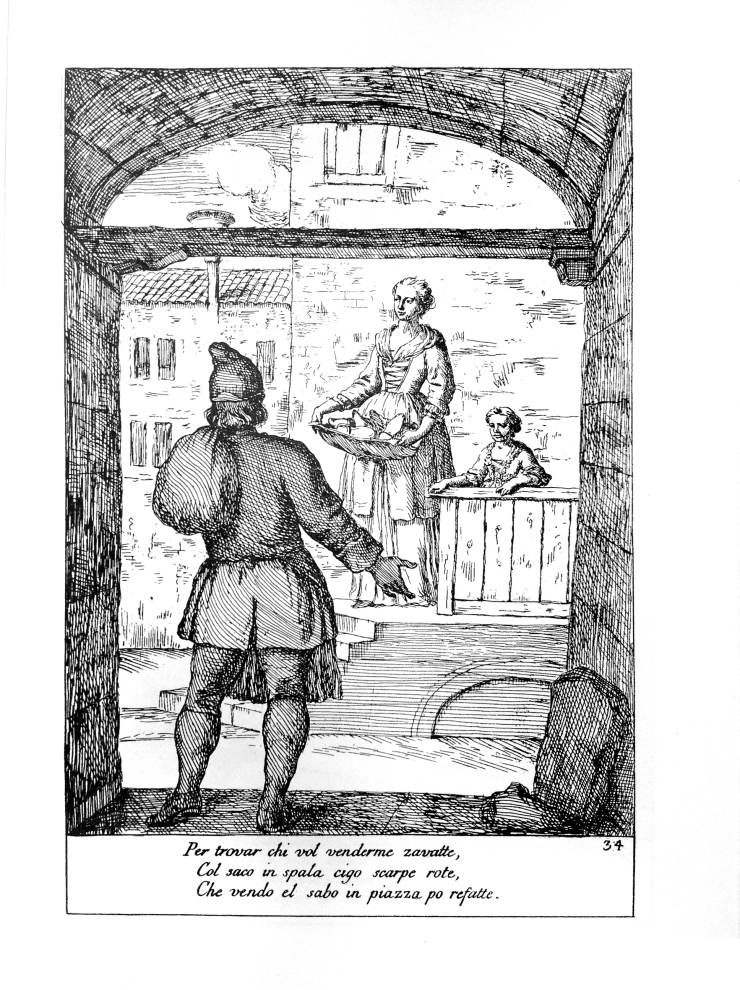
Plate 34: The used shoe collector and salesman.
Original Venetian text:
Per trovar chi vol venderme zavatte,
Col saco in spala cigo scarpe rote,
Che vendo el sabo in piazza po refatte.
From Le arti che vanno per via nella città di Venezia, 1746-1754
Etching by Gaetano Zompini
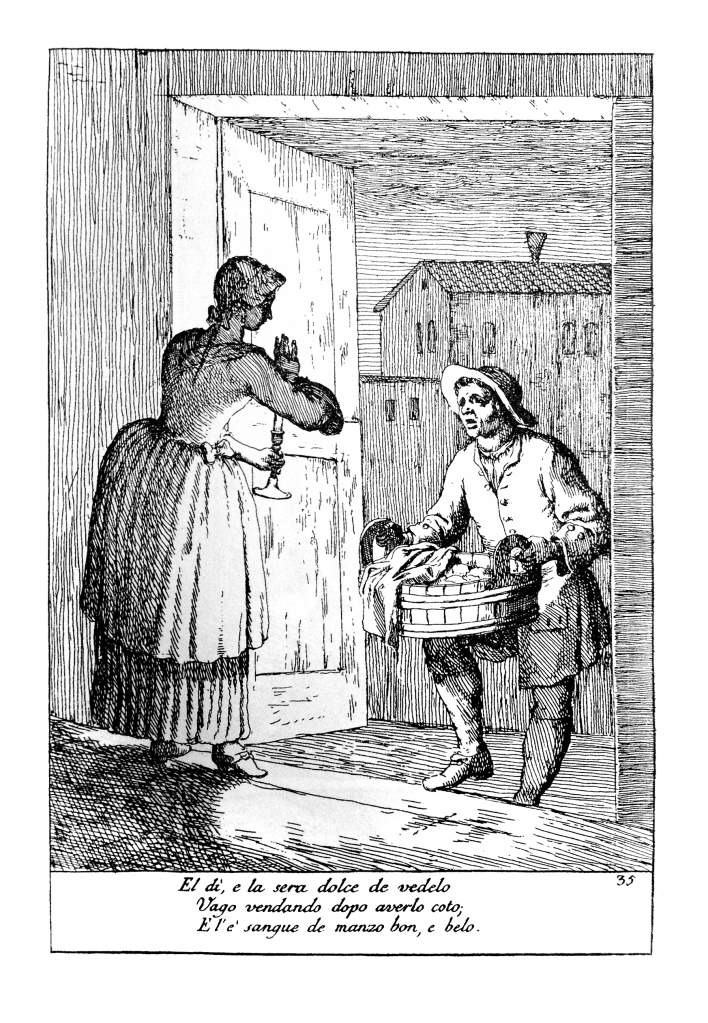
Plate 35: The black pudding pedlar.
Original Venetian text:
El dì, e la sera dolce de vedelo
Vago vendando dopo averlo coto;
E l’è sangue de manzo bon, e belo.
From Le arti che vanno per via nella città di Venezia, 1746-1754
Etching by Gaetano Zompini
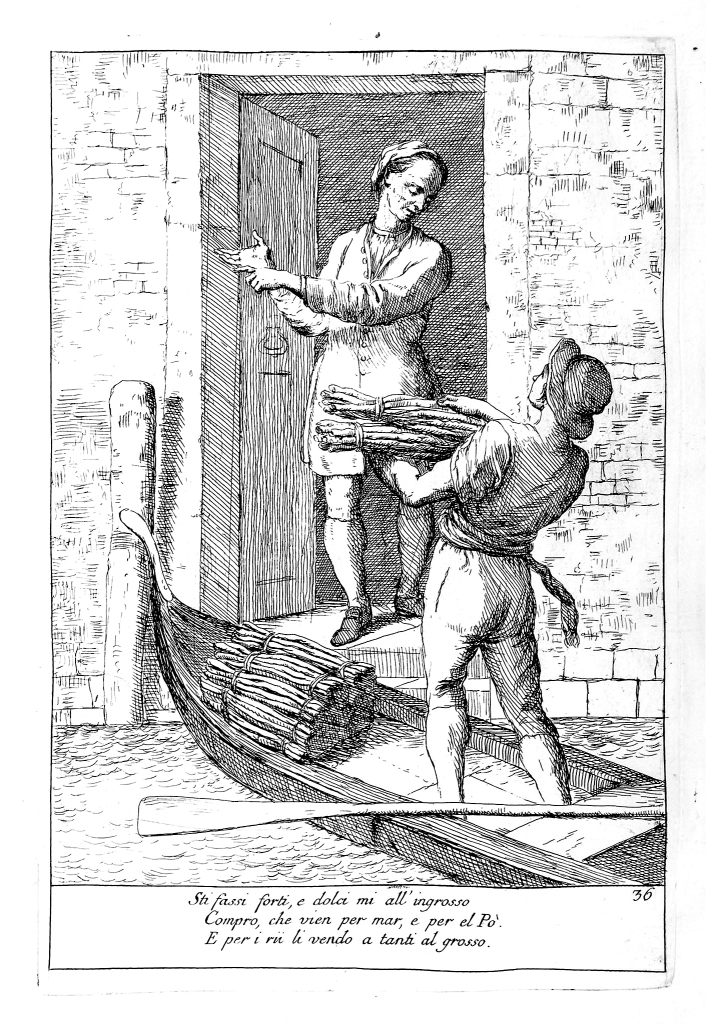
Plate 36: The kindling wood seller.
Original Venetian text:
Sti fassi forti, e dolci mi all’ingrosso
Compro, che vien per mar, e per el Pò.
E per i rii li vendo a tanti al grosso.
From Le arti che vanno per via nella città di Venezia, 1746-1754
Etching by Gaetano Zompini
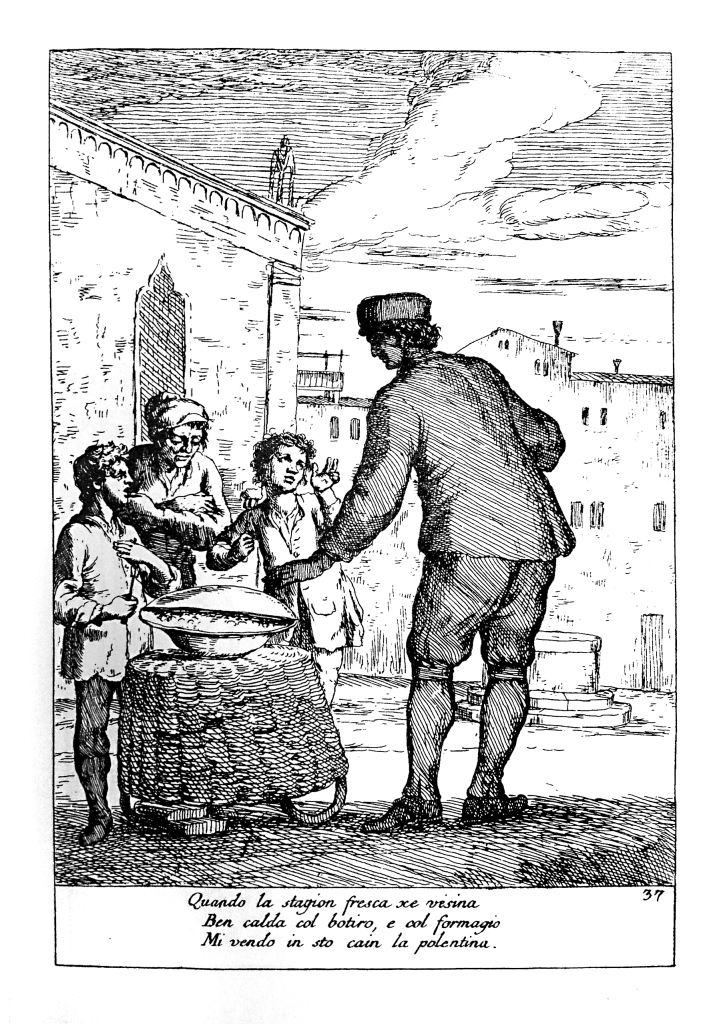
Plate 37: The man selling hot polenta with butter and cheese.
Original Venetian text:
Quando la stagion fresca xe visina
Ben calda col botiro, e col formagio
Mi vendo in sto cain la polentina.
From Le arti che vanno per via nella città di Venezia, 1746-1754
Etching by Gaetano Zompini
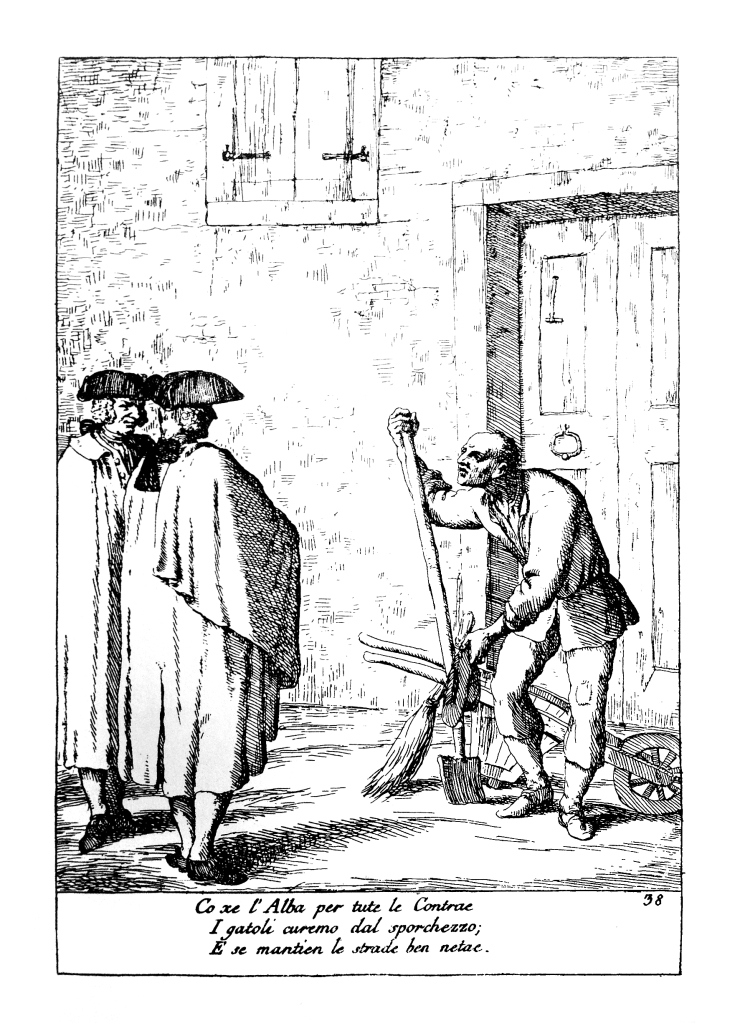
Plate 38: The street cleaner.
Original Venetian text:
Co xe l’alba per tute le contrae
I gatoli curemo dal sporchezzo;
E se mantien le strade ben netae.
From Le arti che vanno per via nella città di Venezia, 1746-1754
Etching by Gaetano Zompini
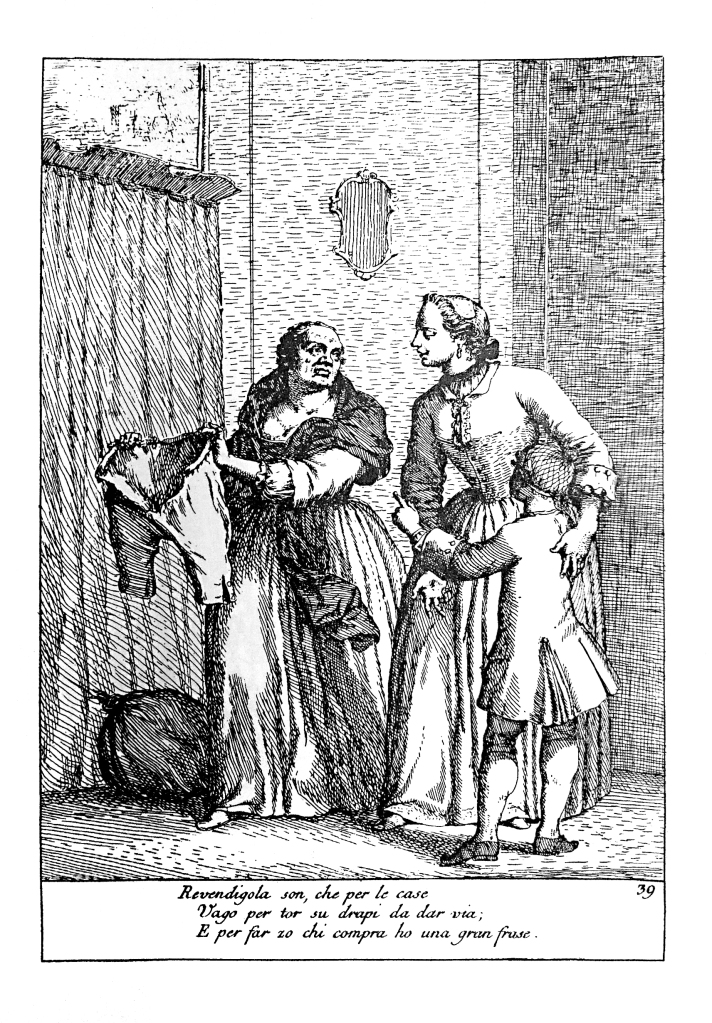
Plate 39: The used clothes collector and seller.
Original Venetian text:
Revendigola son, che per le case
Vago per tor su drapi da dar via;
E per far zo chi compra ho una gran frase.
From Le arti che vanno per via nella città di Venezia, 1746-1754
Etching by Gaetano Zompini
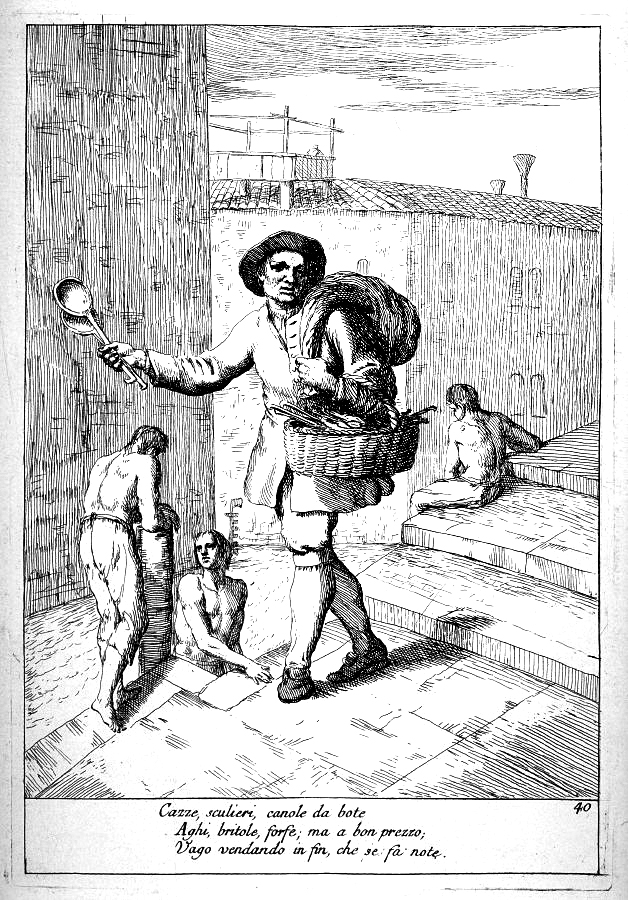
Plate 40: The strolling pedlar selling utensils.
Original Venetian text:
Cazze, sculieri, canole da bote
Aghi, britole, forfe; ma a bon prezzo;
Vago vendando in fin, che se fa note.
From Le arti che vanno per via nella città di Venezia, 1746-1754
Etching by Gaetano Zompini
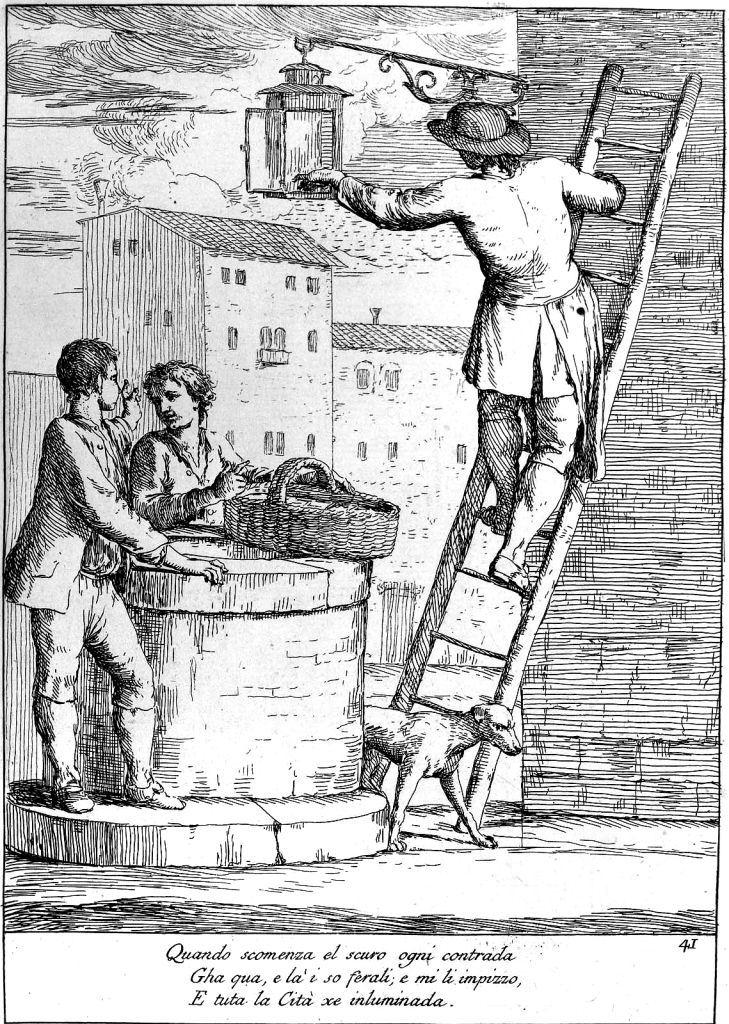
Plate 41: The lantern lighter.
Original Venetian text:
Quando scomenza el scuro ogni contrada
Gha qua, e là i so ferali; e mi li impizzo,
E tuta la Cità xe inluminada.
From Le arti che vanno per via nella città di Venezia, 1746-1754
Etching by Gaetano Zompini
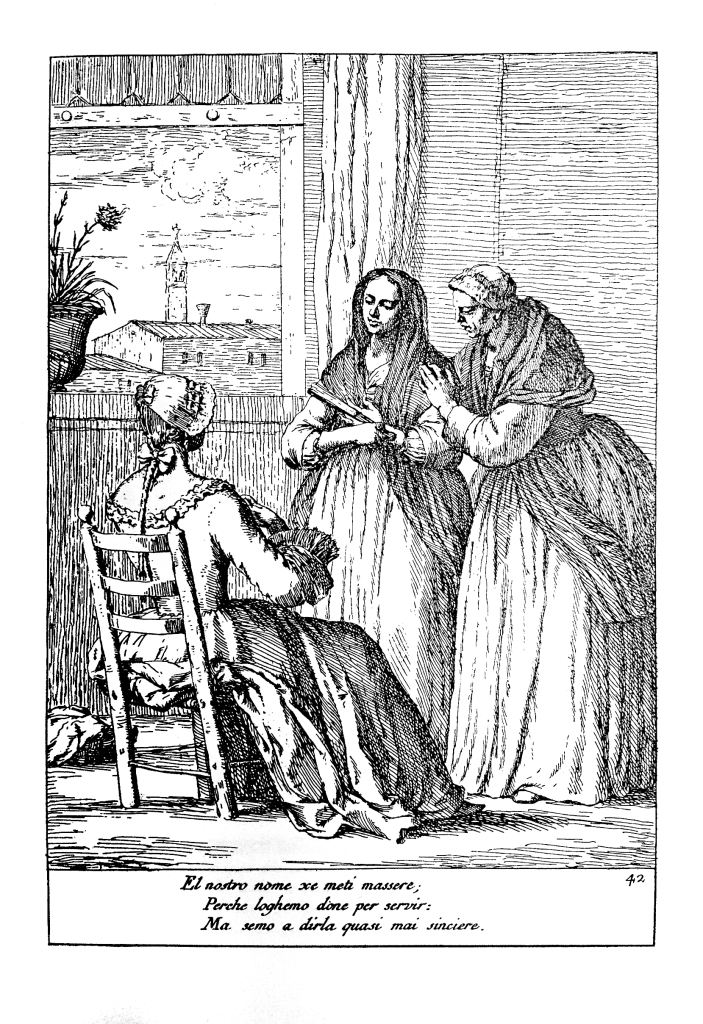
Plate 42: The domestic workers and caregivers agent presents a candidate.
Original Venetian text:
El nostro nome xe meti massere;
Perche loghemo done per servir:
Ma semo a dirla quasi mai sinciere.
From Le arti che vanno per via nella città di Venezia, 1746-1754
Etching by Gaetano Zompini
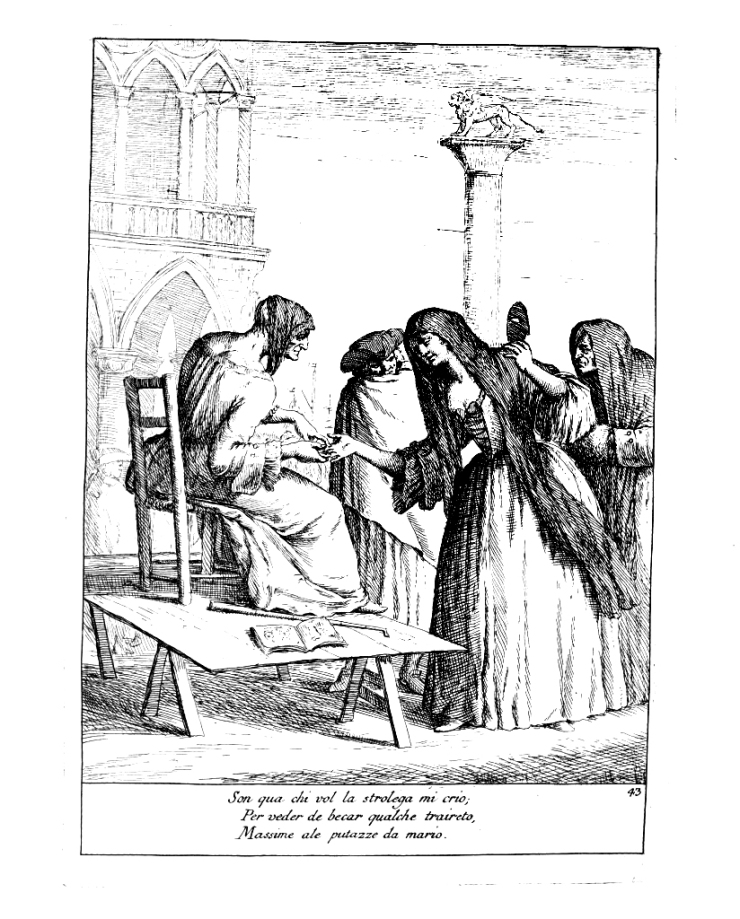
Plate 43: The fortune teller/palm reader.
Original Venetian text:
Son qua chi vol la strolega mi crio;
Per veder de becar qualche traireto,
Massime alle putazze da mario.
From Le arti che vanno per via nella città di Venezia, 1746-1754
Etching by Gaetano Zompini
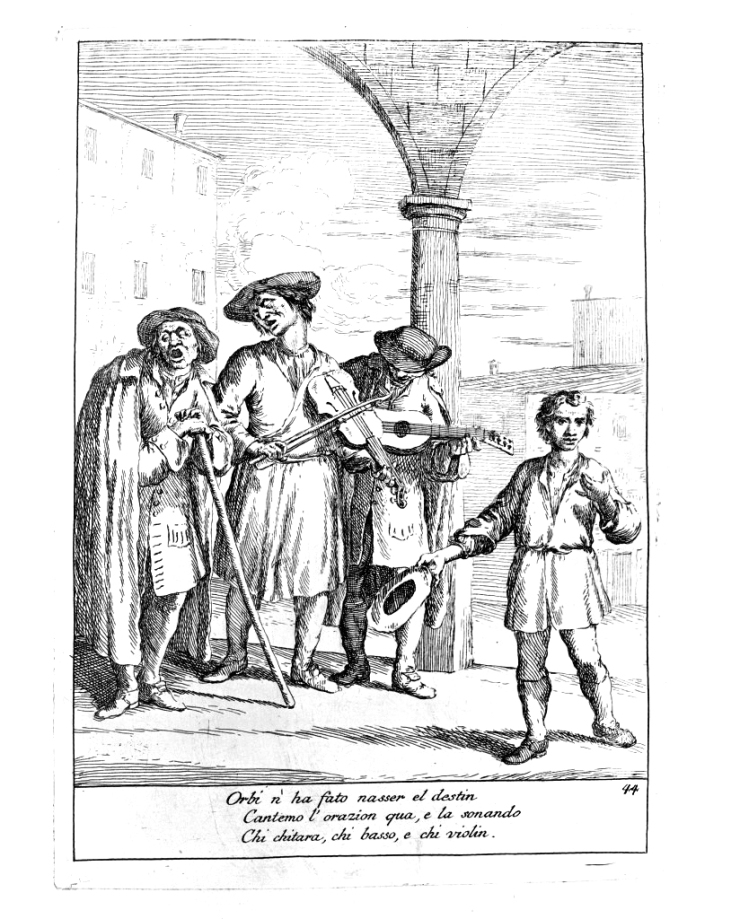
Plate 44: The blind street minstrels and the money collector.
Original Venetian text:
Orbi n’ha fato nassere el destin
Cantemo l’orazion qua, e la sonando
Chi chitara, chi basso, e chi violin.
From Le arti che vanno per via nella città di Venezia, 1746-1754
Etching by Gaetano Zompini
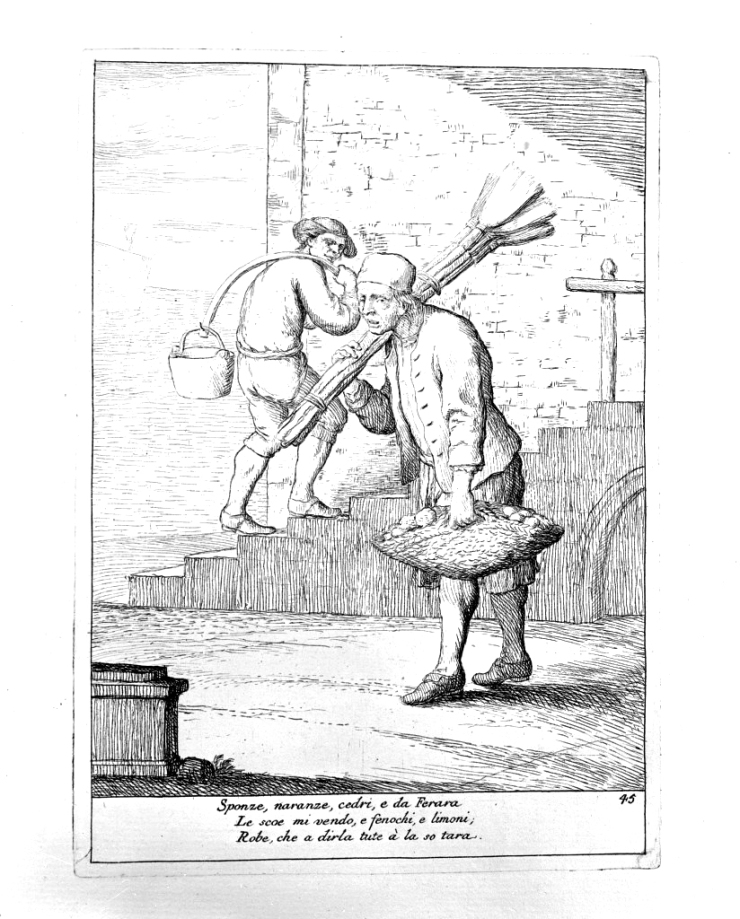
Plate 45: The broom seller, also peddling sponges, citrus fruits and fennel.
Original Venetian text:
Sponze, naranze, cedri, e da Ferara
Le scoe mi vendo, e fenochi, e limoni;
Robe che a dirla tute à la so tara.
From Le arti che vanno per via nella città di Venezia, 1746-1754
Etching by Gaetano Zompini
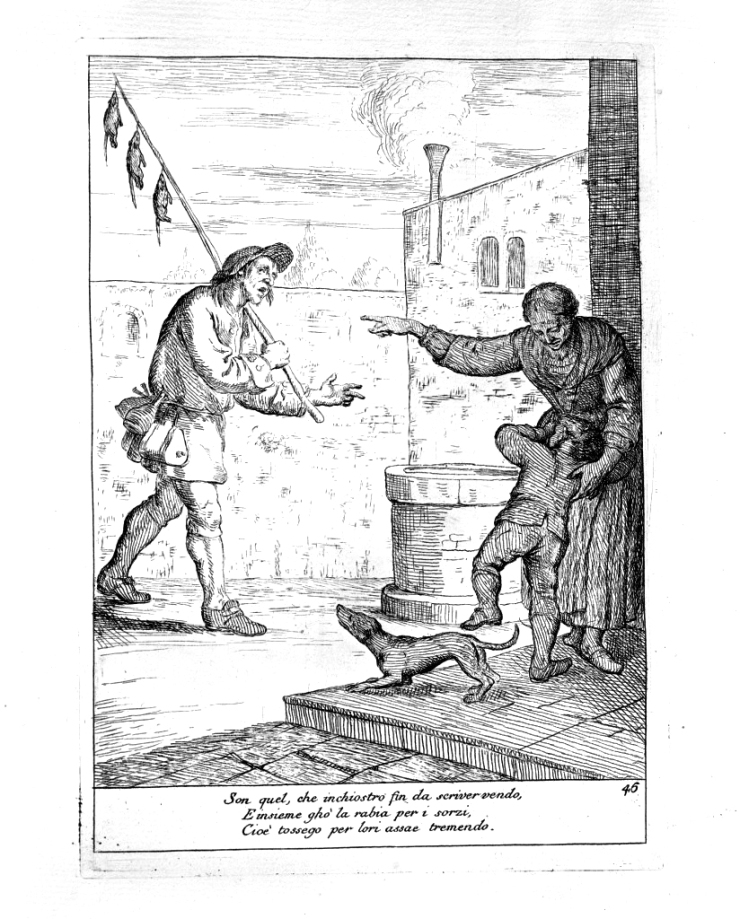
Plate 46: The ink and rat poison seller.
Original Venetian text:
Son quel, che inchiostro fin da scriver vendo,
E insieme ghò la roba per i sorzi,
Cioè tossego per lori assae tremendo.
From Le arti che vanno per via nella città di Venezia, 1746-1754
Etching by Gaetano Zompini
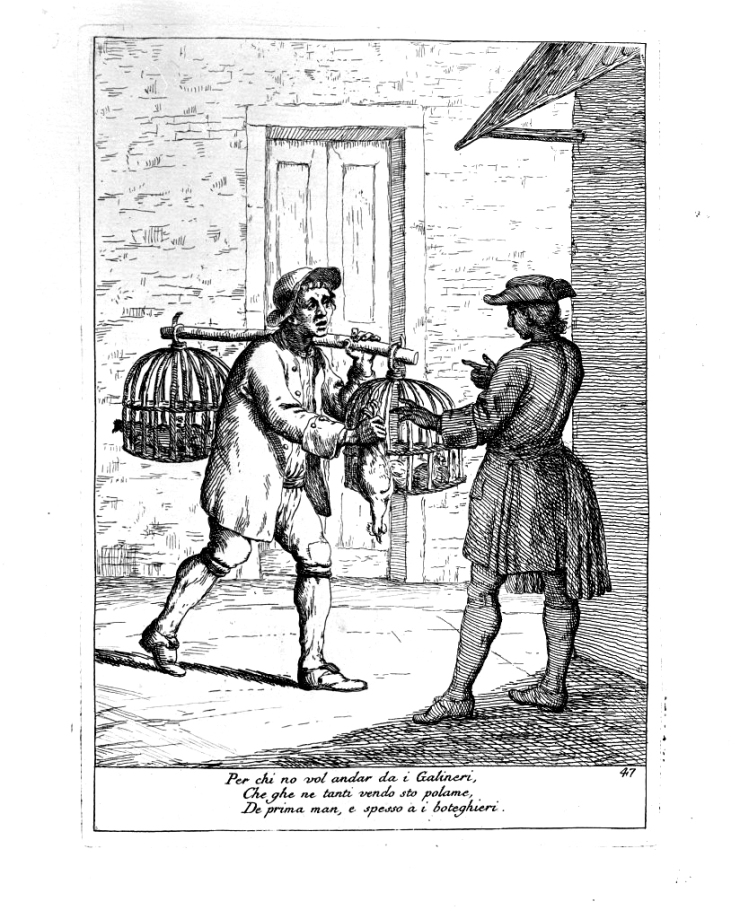
Plate 47: The poulterer.
Original Venetian text:
Per chi no vol andar da i galineri,
Che ghe ne tanti vendo sto polame,
De prima man, e spesso a i boteghieri.
From Le arti che vanno per via nella città di Venezia, 1746-1754
Etching by Gaetano Zompini
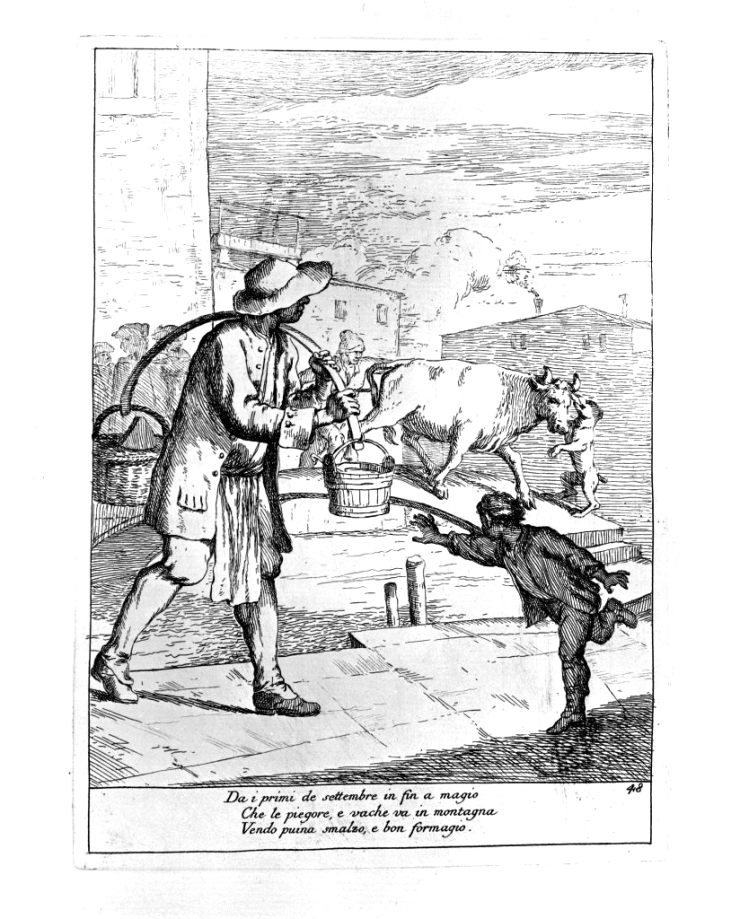
Plate 48: The butter and ricotta cheese vendor.
Original Venetian text:
Da i primi de settembre in fin a maggio
Che le piegore, e vache va in montagna
Vendo puina smalzo, e bon formagio
From Le arti che vanno per via nella città di Venezia, 1746-1754
Etching by Gaetano Zompini
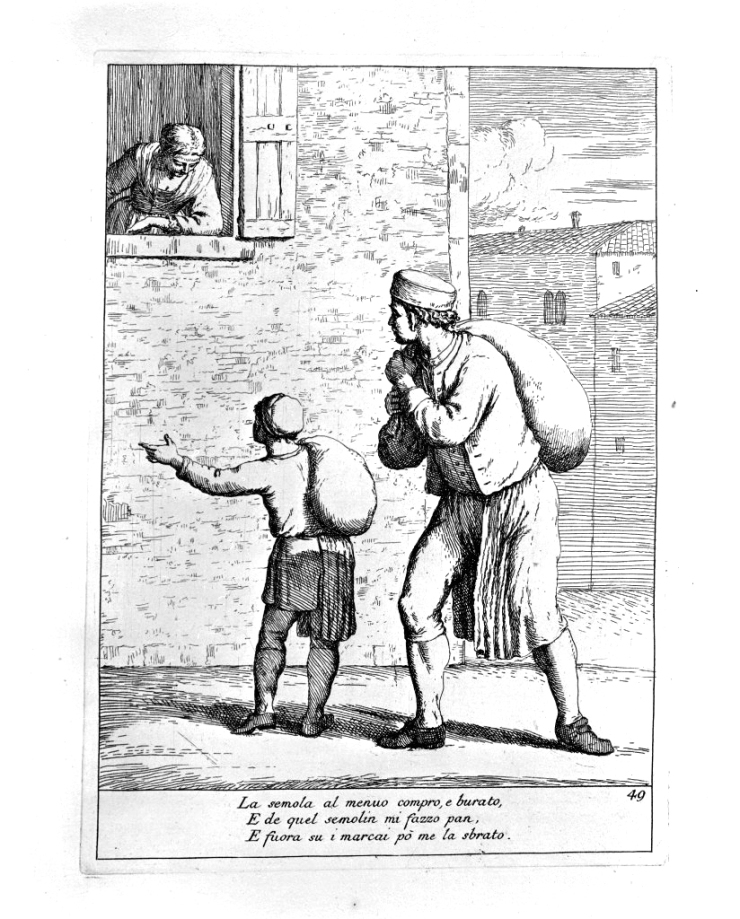
Plate 49: The semolina supplier.
Original Venetian text:
La semola al menuo compro, e burato,
E de quel semolin mi fazzo pan,
E fuori su i mercai pò me la sbrato.
From Le arti che vanno per via nella città di Venezia, 1746-1754
Etching by Gaetano Zompini
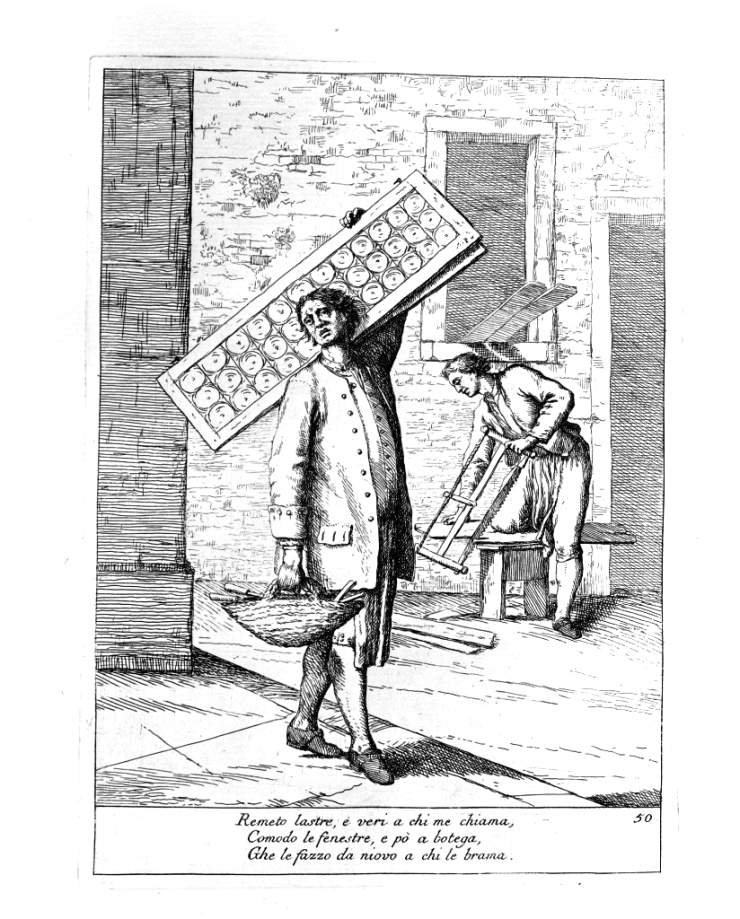
Plate 50: The window repairer.
Original Venetian text:
Remeto lastre, e veri a chi me chiama,
Comodo le fenestre, e pò a botega,
Ghe le fazzo da niovo a chi le brama.
From Le arti che vanno per via nella città di Venezia, 1746-1754
Etching by Gaetano Zompini
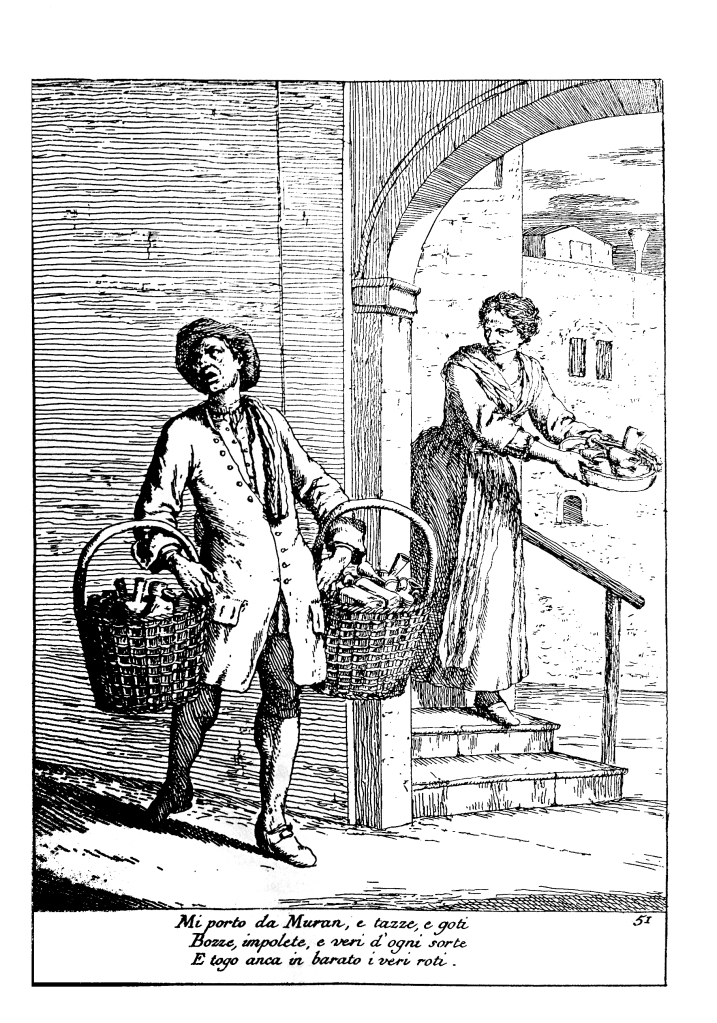
Plate 51: The glass pedlar and collector of broken glass, from Murano.
Original Venetian text:
Mi porto da Muran, e tazze, e goti
Bozze, impolete e veri d’ogni sorte
E togo anca in barato i veri roti.
From Le arti che vanno per via nella città di Venezia, 1746-1754
Etching by Gaetano Zompini
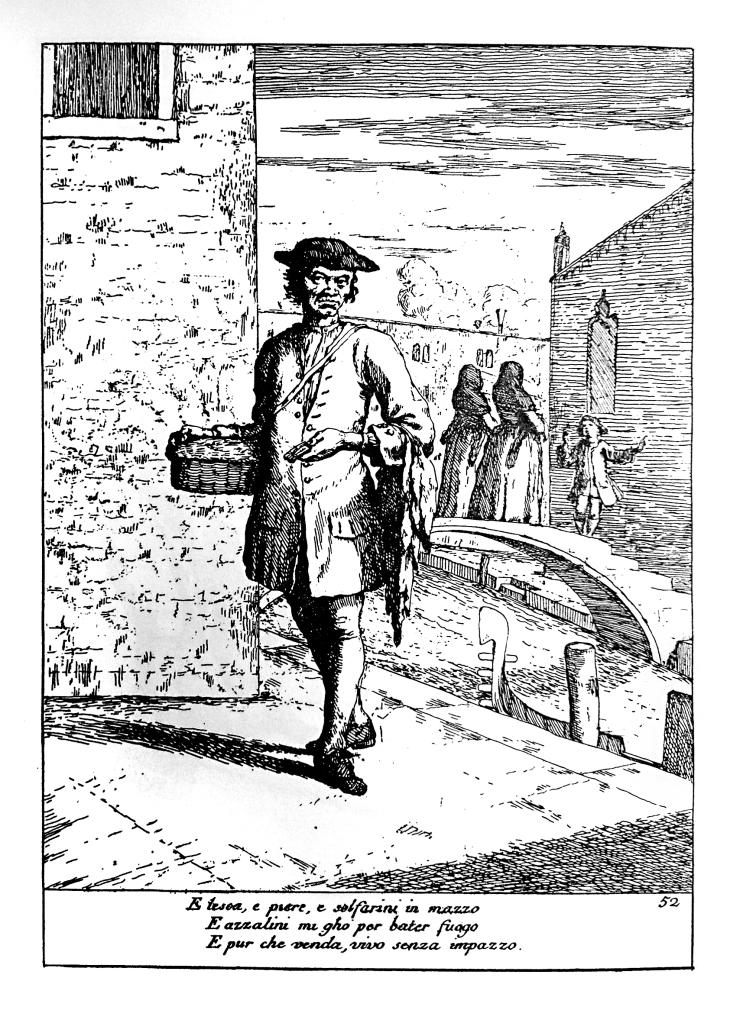
Plate 52: The tinder and flint fire-lighter salesman.
Original Venetian text:
E lesca, e piere, e solfarini in mazzo
E azzalini mi gho per bater fuogo
E pur che venda, vivo senza impazzo.
From Le arti che vanno per via nella città di Venezia, 1746-1754
Etching by Gaetano Zompini
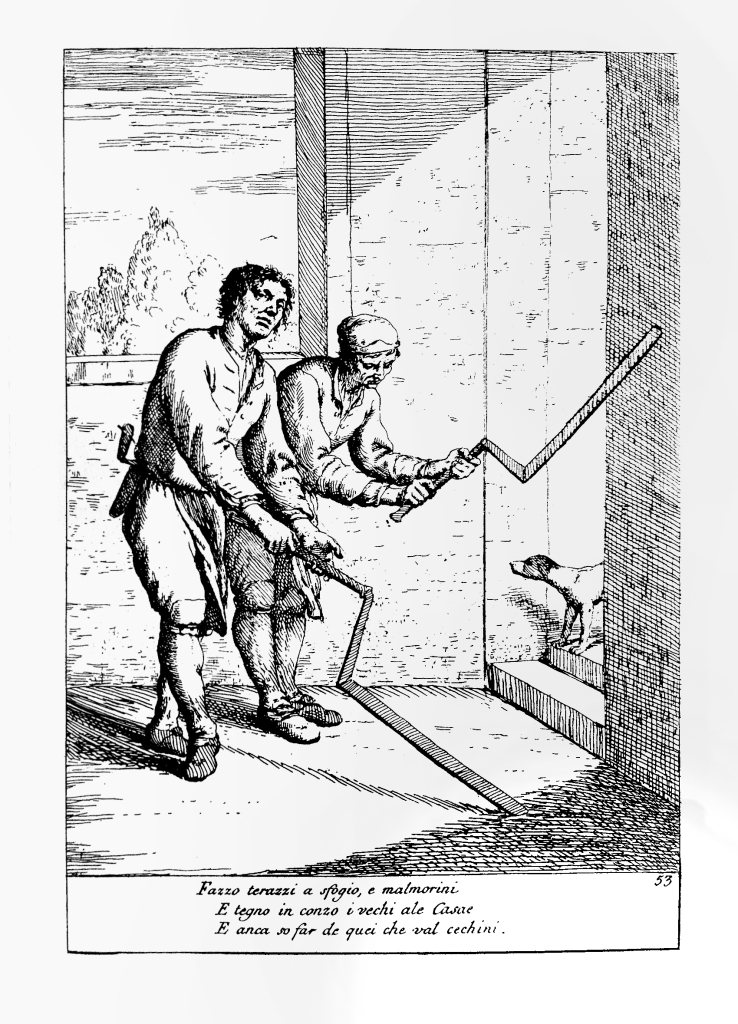
Plate 53: The masons measuring up for the new floor.
Original Venetian text:
Fazzo terrazzi e sfogio, e malmorini
E tegno in conzo i vechi ale Casae
E anca so far de quei che val cechini.
From Le arti che vanno per via nella città di Venezia, 1746-1754
Etching by Gaetano Zompini
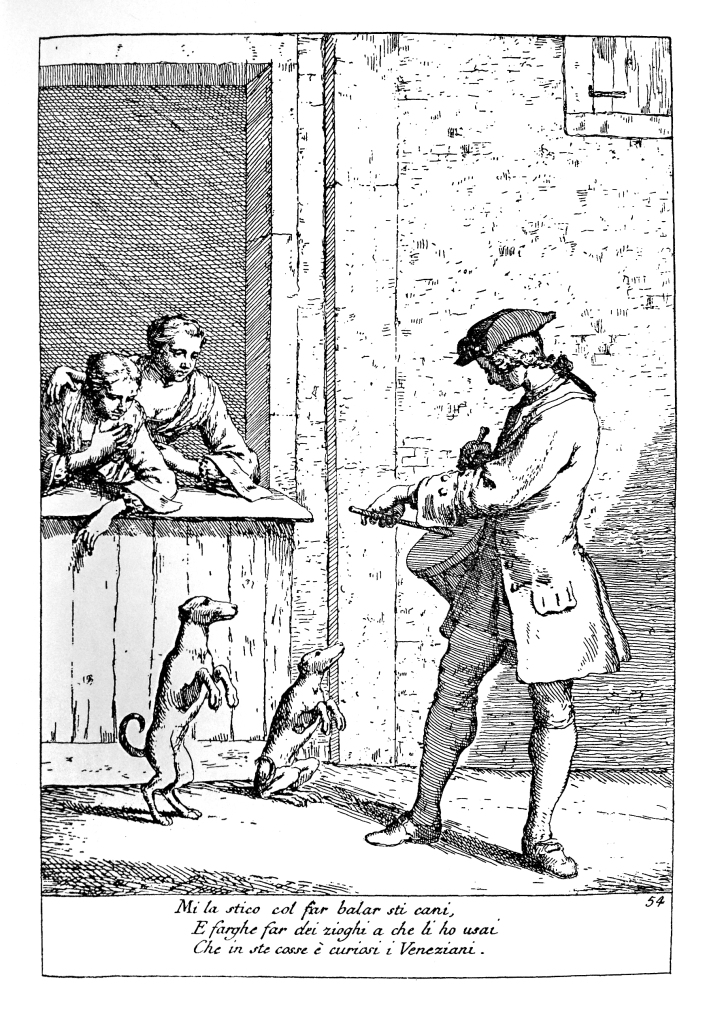
Plate 54: The street entertainer with his dancing dogs.
Original Venetian text:
Mi la stico col far balar sti cani,
E farghe far dei zioghi a che li ho usai
Che in ste cosse è curiosi i Veneziani.
From Le arti che vanno per via nella città di Venezia, 1746-1754
Etching by Gaetano Zompini
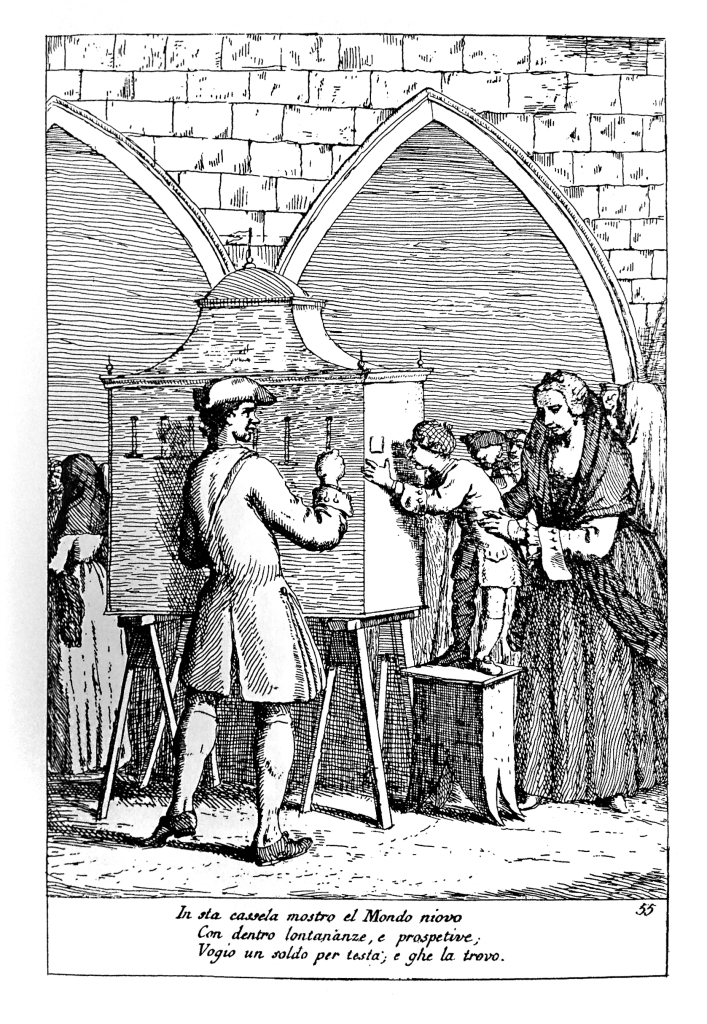
Plate 55: The peep box operator.
Original Venetian text:
In sta cassela mostro el Mondo niovo
Con dentro lontananze, e prospetive;
Vogio un soldo per testa; e ghe la trovo.
From Le arti che vanno per via nella città di Venezia, 1746-1754
Etching by Gaetano Zompini
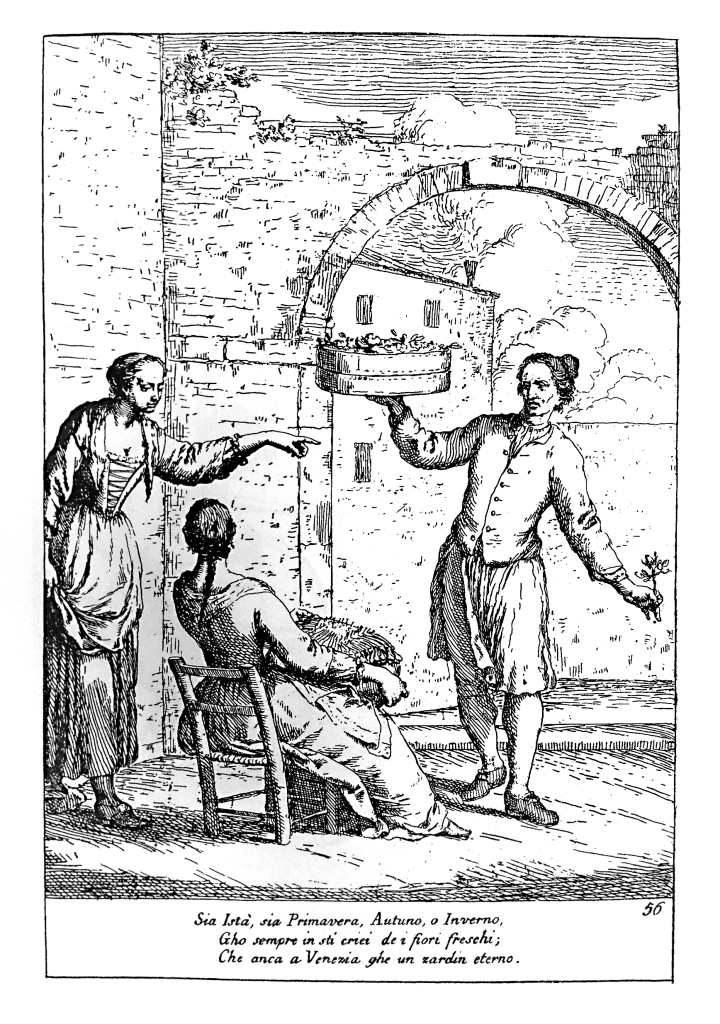
Plate 56: The flower seller.
Original Venetian text:
Sia Istà, sia Primavera, Autuno, o Inverno,
Gho sempre in sti criei dei fiori freschi;
Che anca a Venezia ghe un zardin eterno.
From Le arti che vanno per via nella città di Venezia, 1746-1754
Etching by Gaetano Zompini
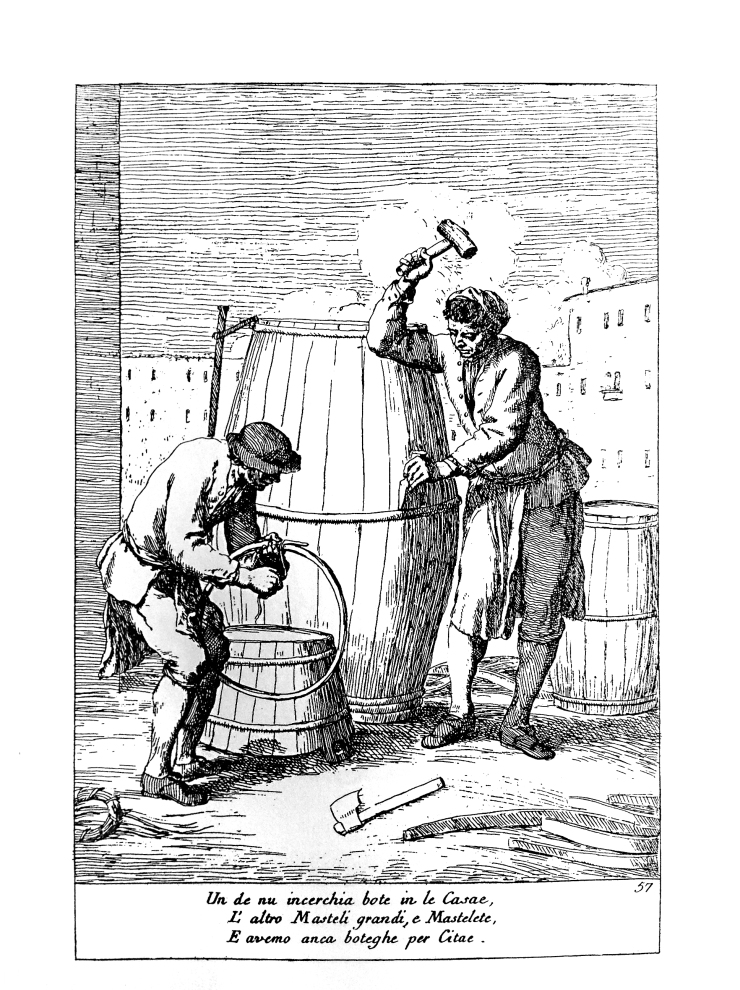
Plate 57: The barrel makers/repairers.
Original Venetian text:
Un de nu incerchia bote in le Casae,
L’altro Masteli grandi, e Mastelete,
E avemo anca boteghe per Citae.
From Le arti che vanno per via nella città di Venezia, 1746-1754
Etching by Gaetano Zompini
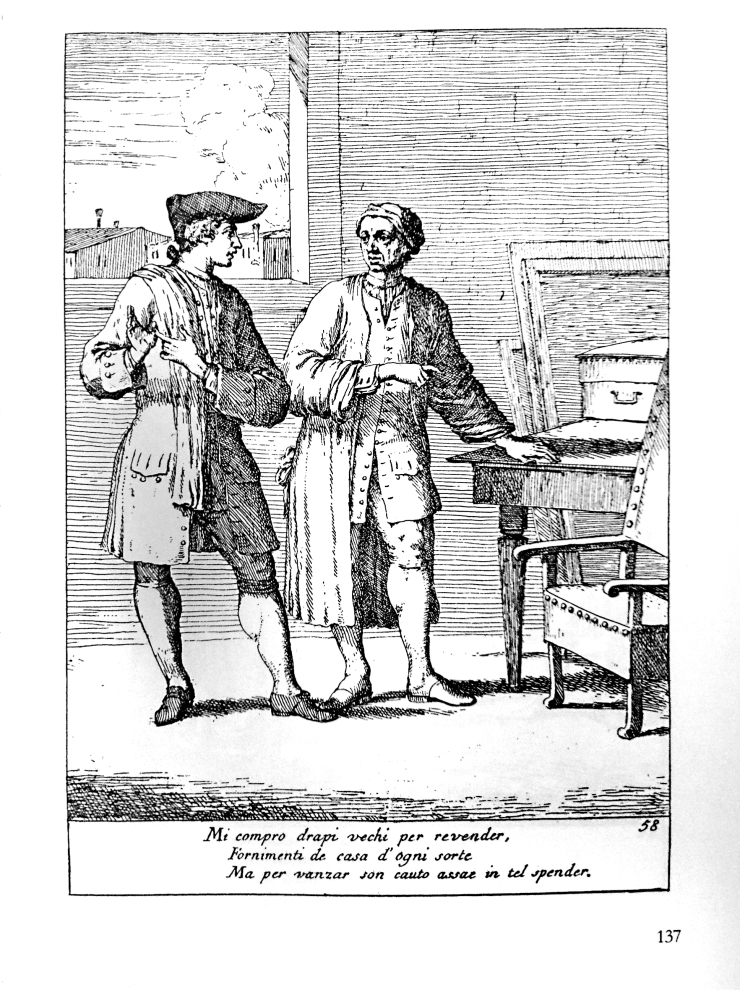
Plate 58: The second-hand furniture dealer.
Original Venetian text:
Mi compro drapi vechi per revender,
Fornimenti de casa d’ogni sorte
Ma per vanzar son cauto assae in tel spender.
From Le arti che vanno per via nella città di Venezia, 1746-1754
Etching by Gaetano Zompini
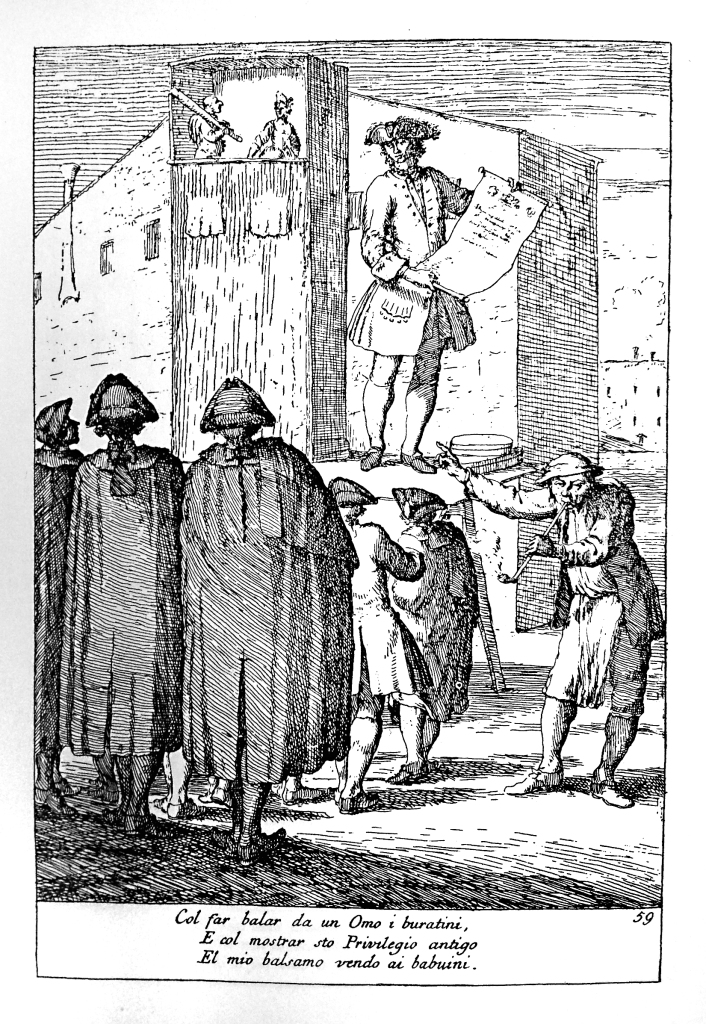
Plate 59: The con artists working the crowd.
Original Venetian text:
Col far balar da un Omo i buratini,
E col mostrar sto Privilegio antigo
El mio balsamo vendo ai babuini.
From Le arti che vanno per via nella città di Venezia, 1746-1754
Etching by Gaetano Zompini
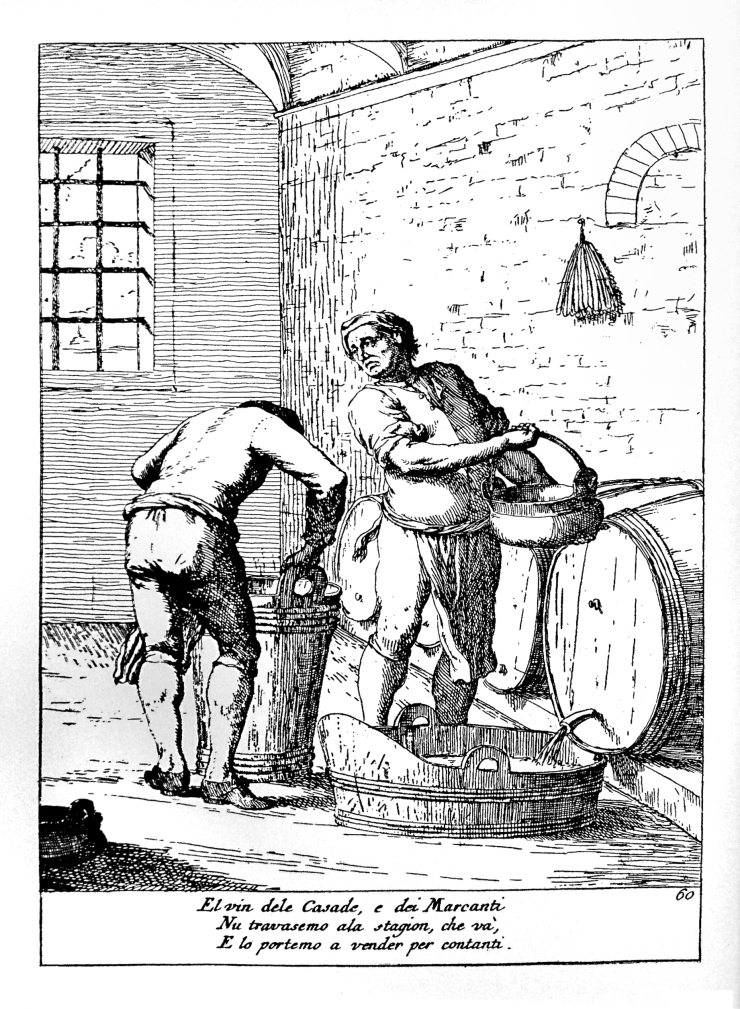
Plate 60: The bulk-wine salesmen.
Original Venetian text:
El vin dele Casade, e dei Mercanti
Nu travasemo ala stagion, che và,
E lo portemo a vender per contanti.
From Le arti che vanno per via nella città di Venezia, 1746-1754
Etching by Gaetano Zompini
